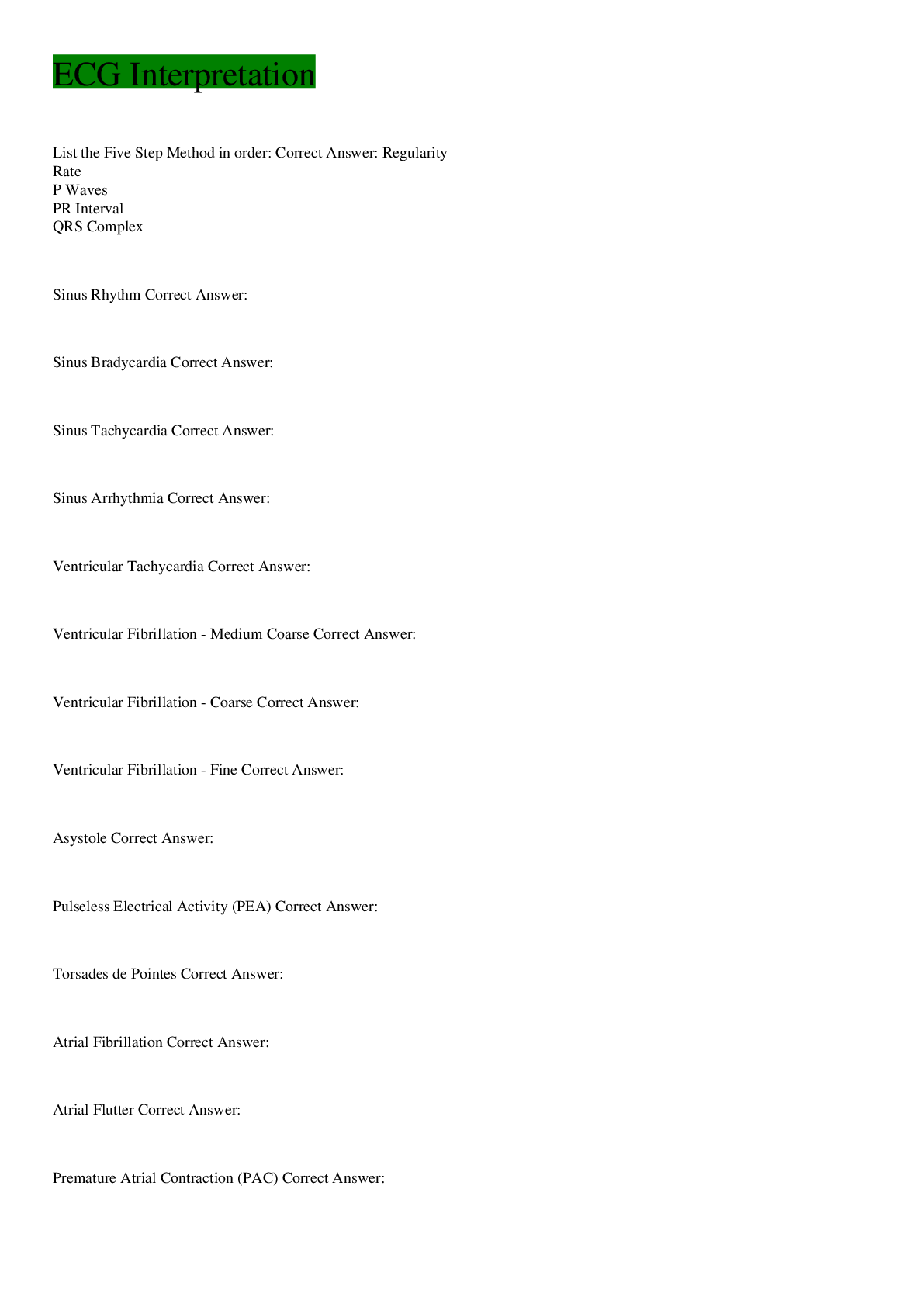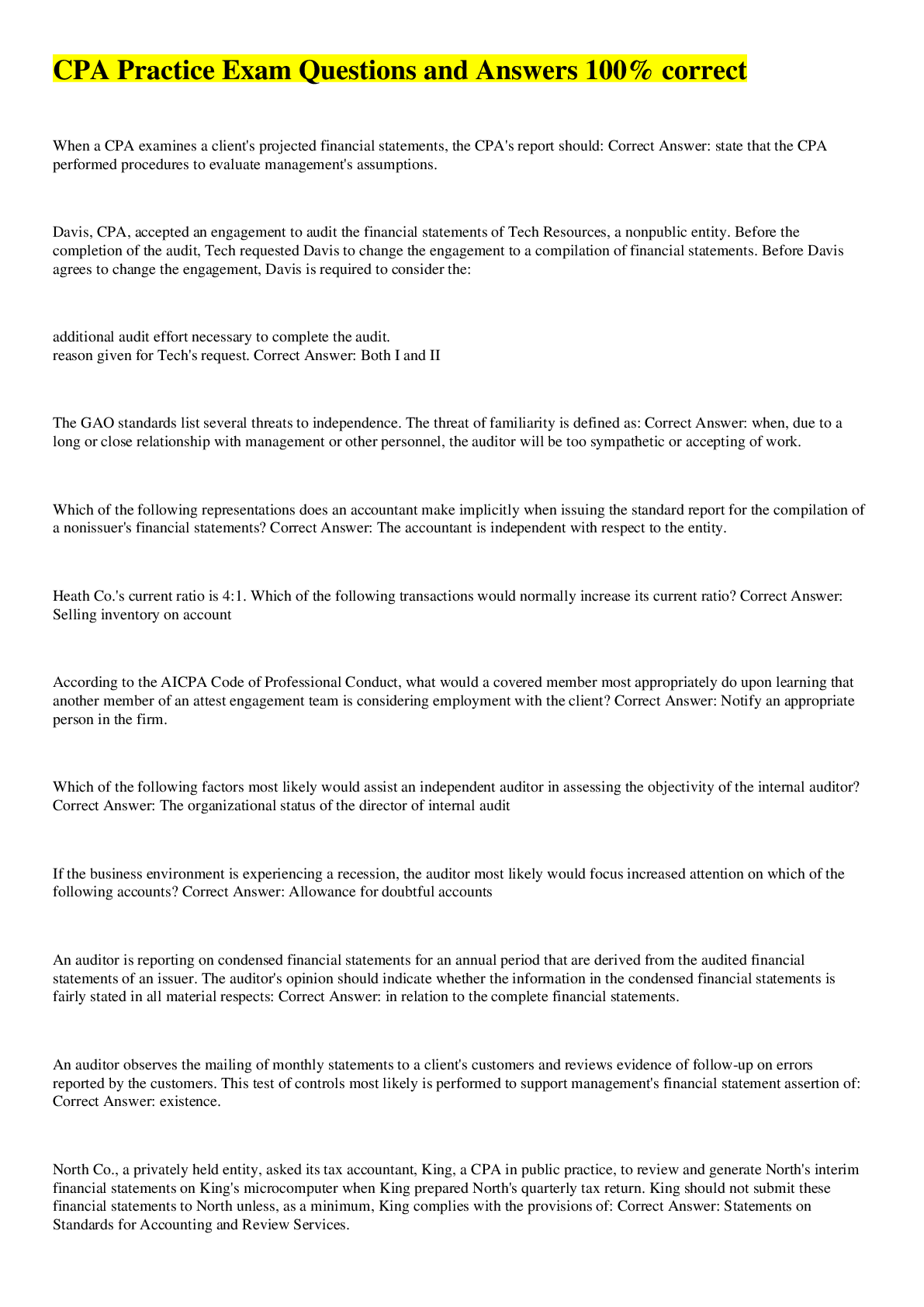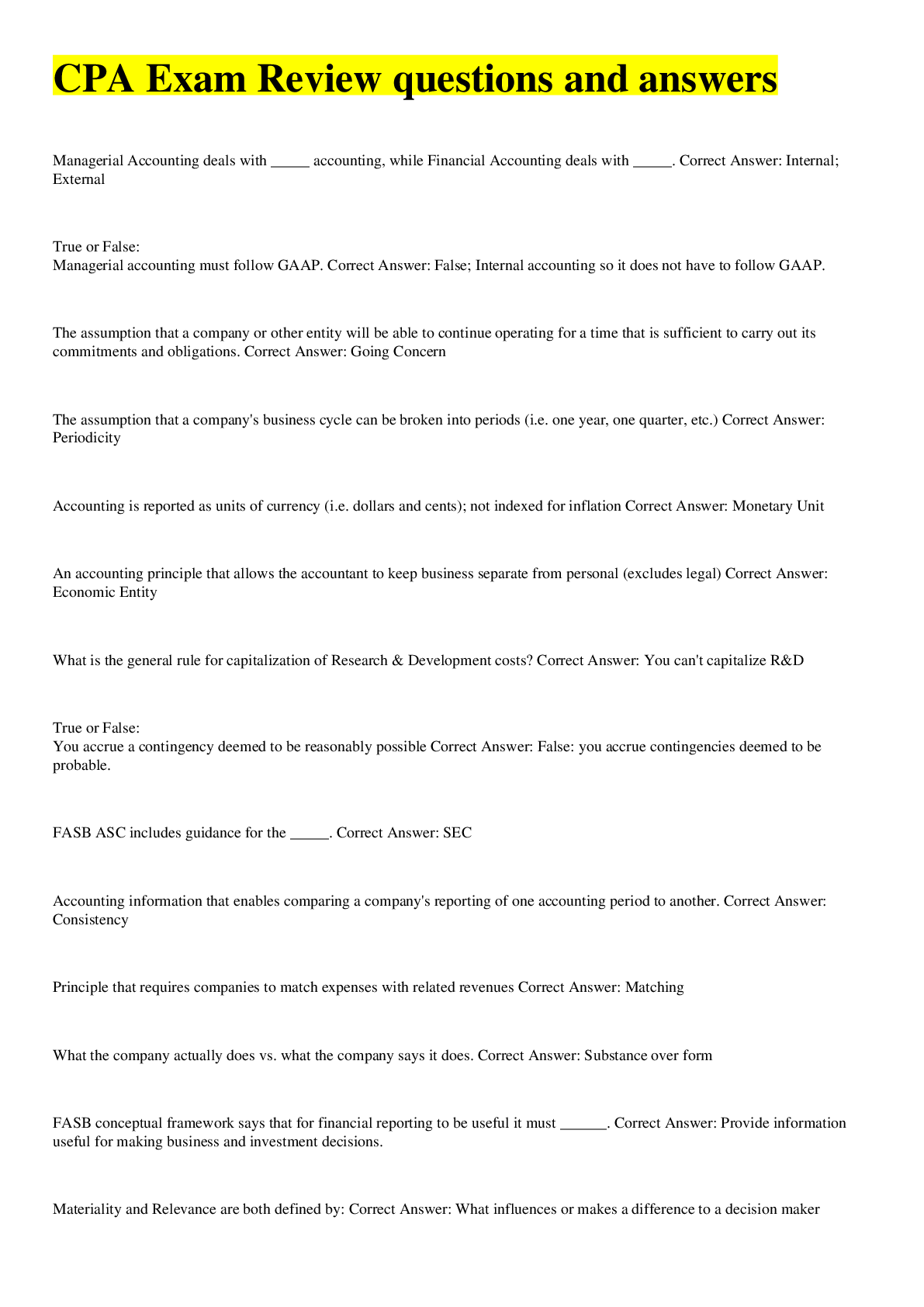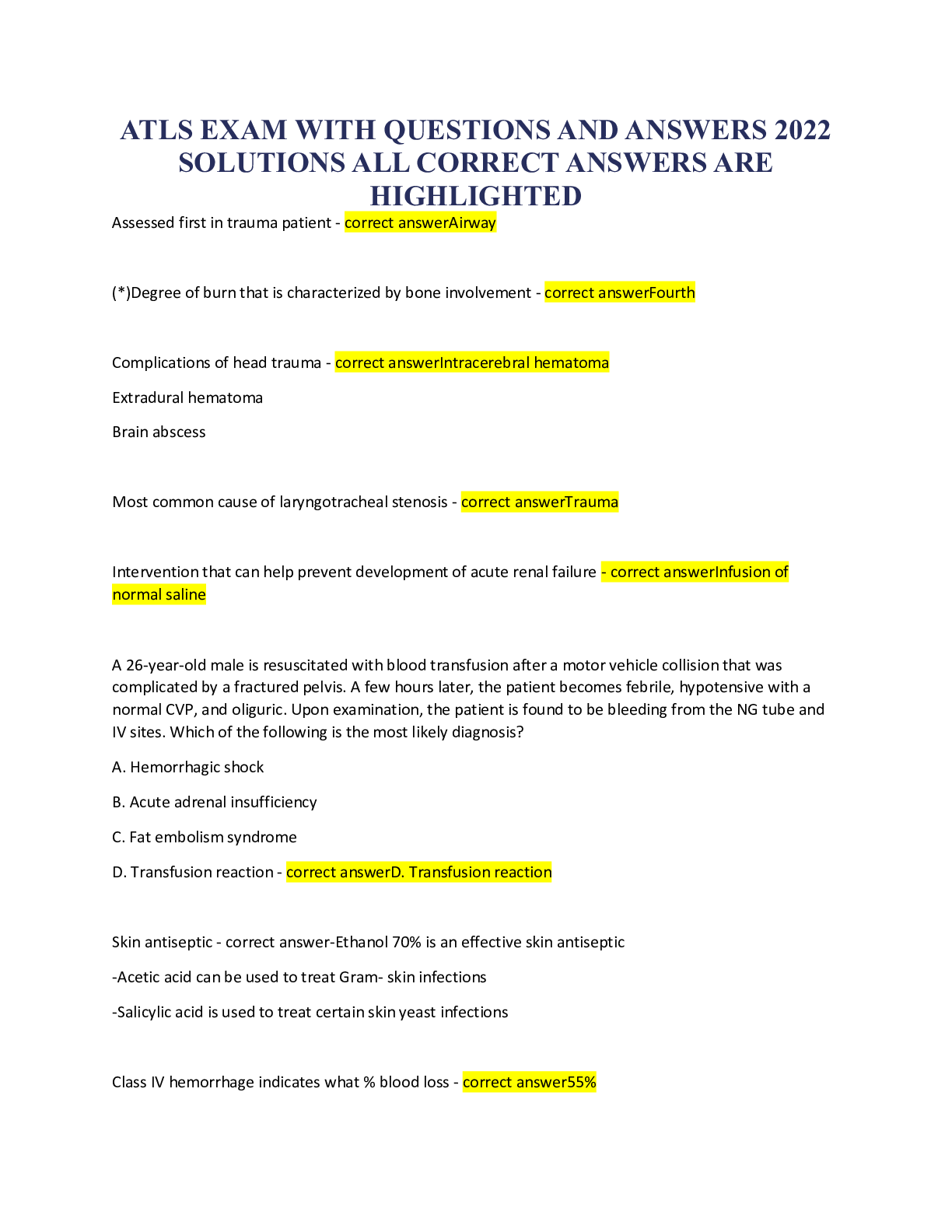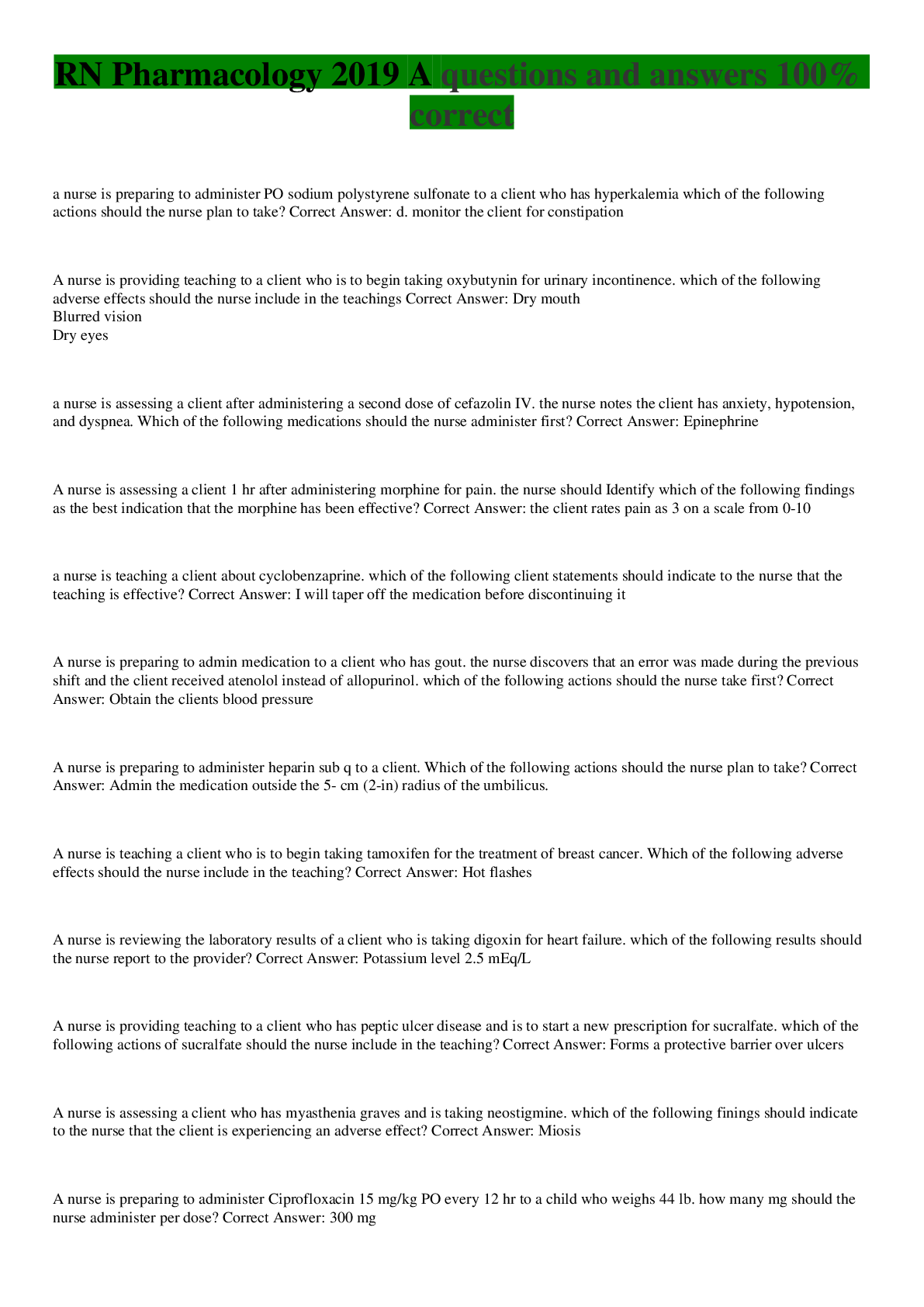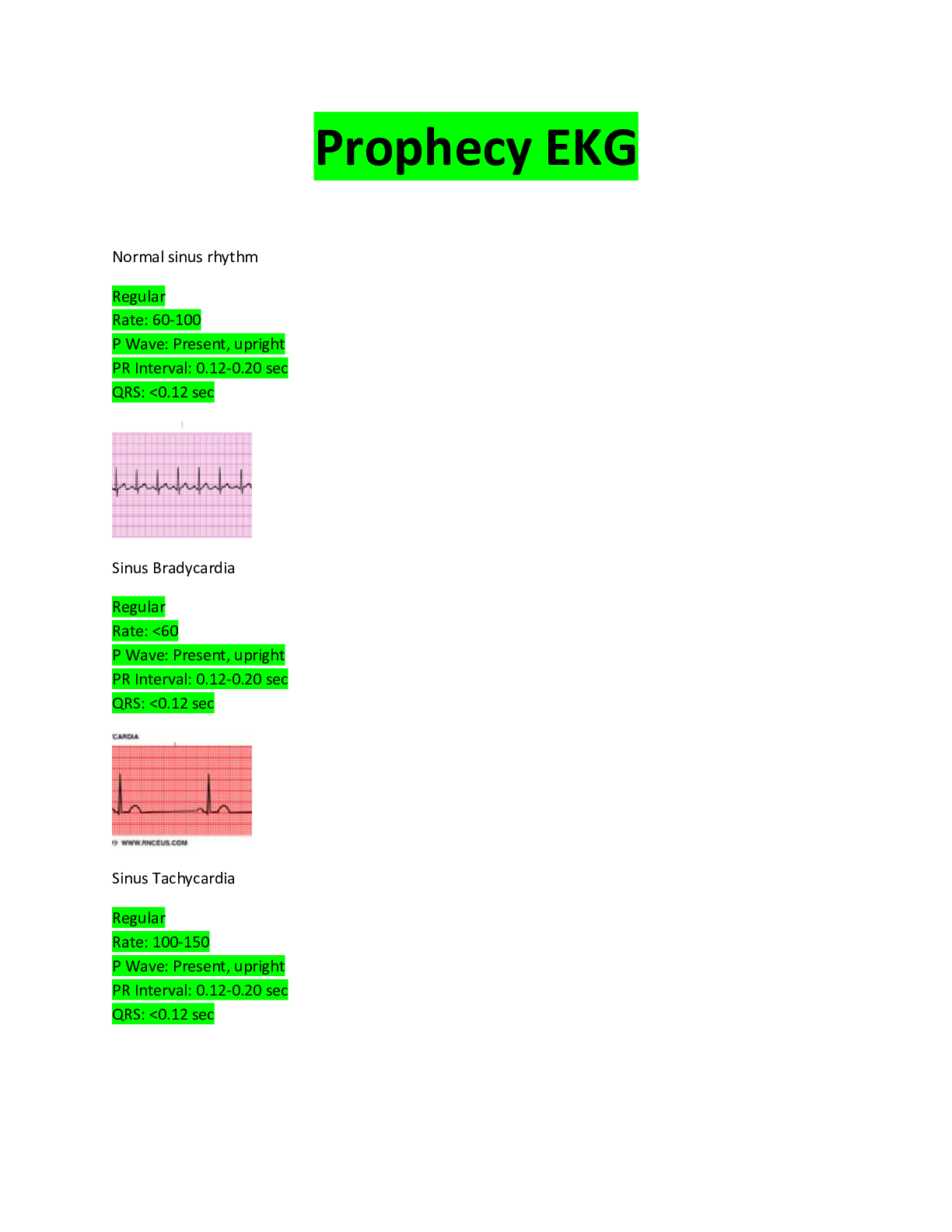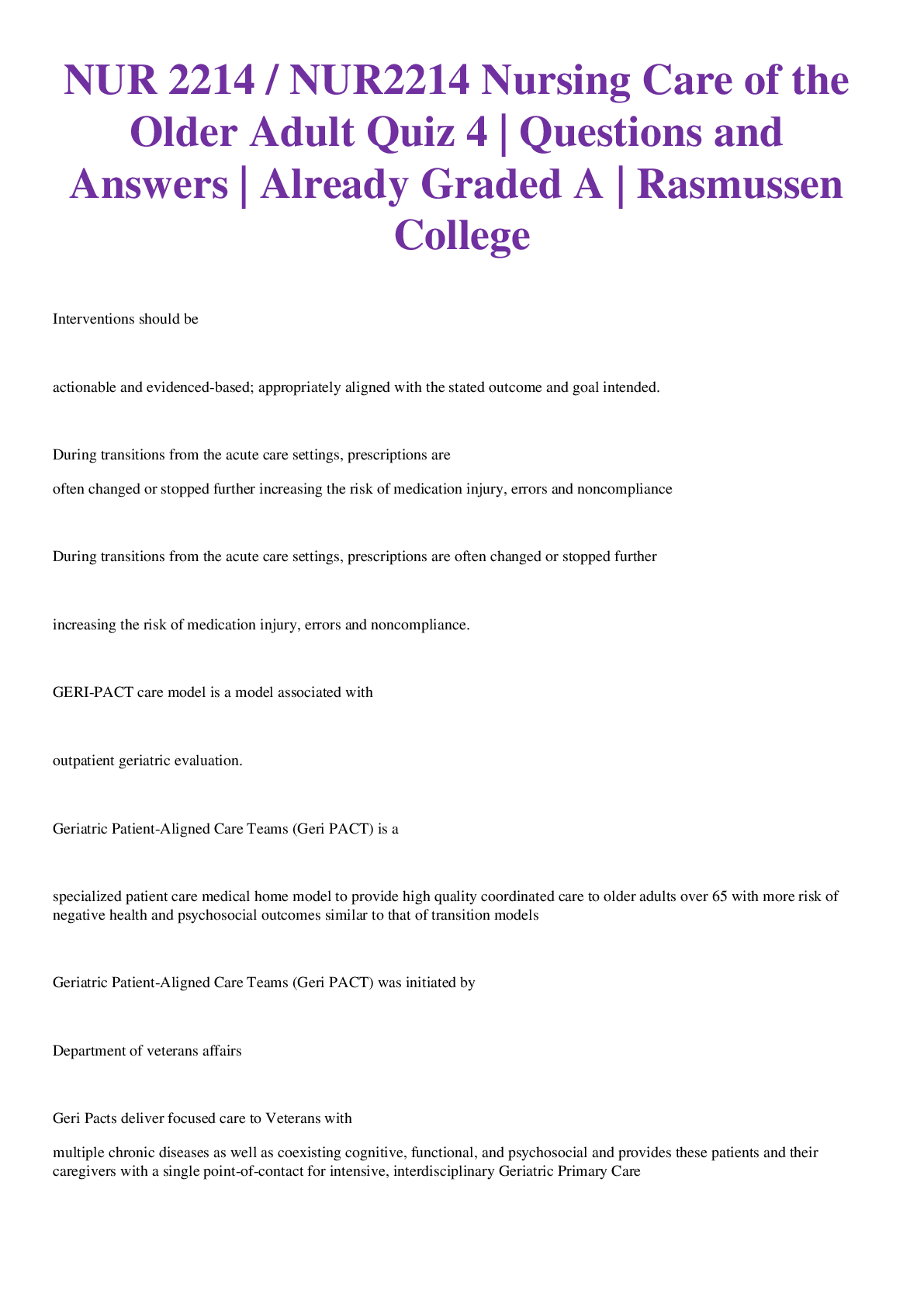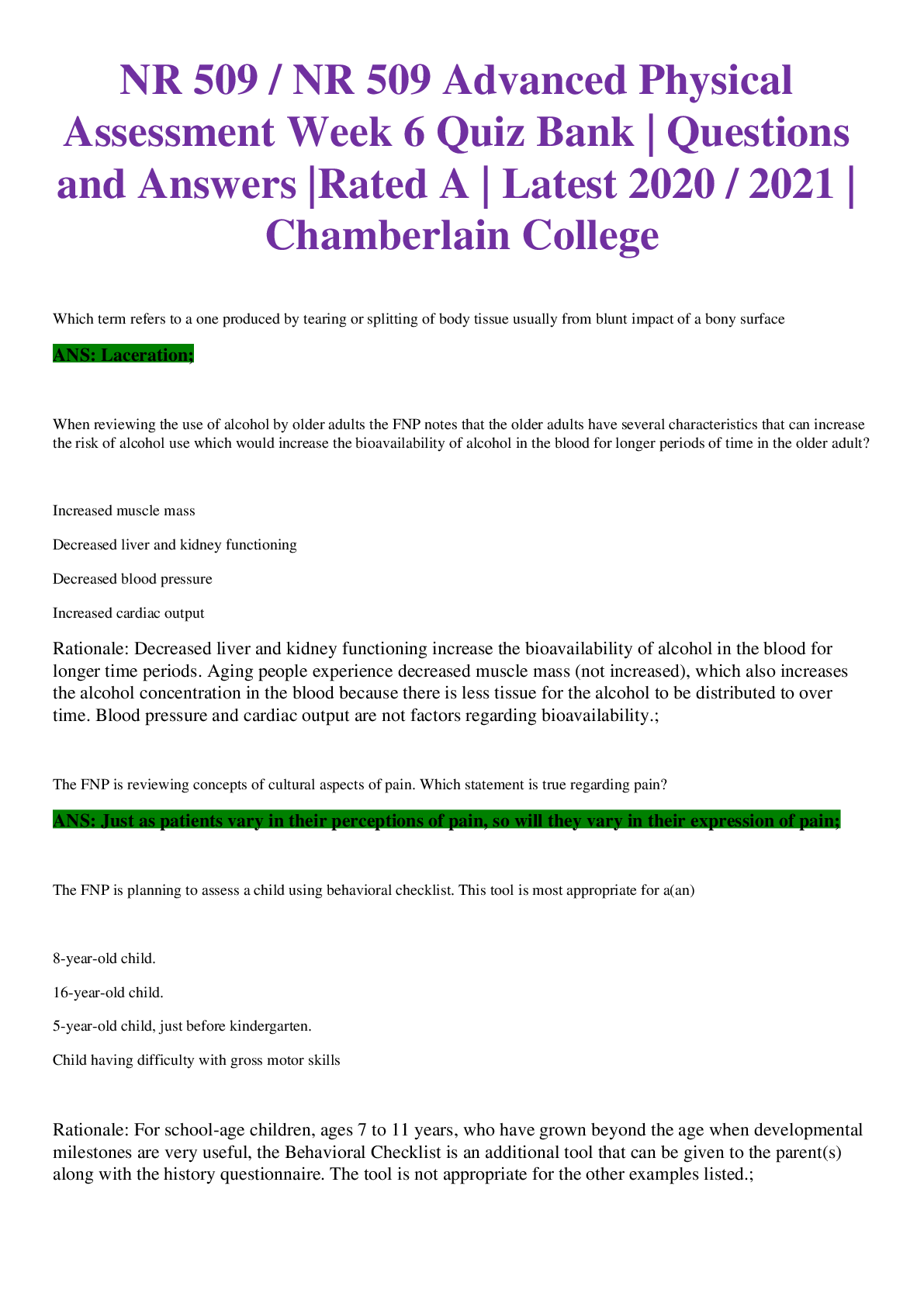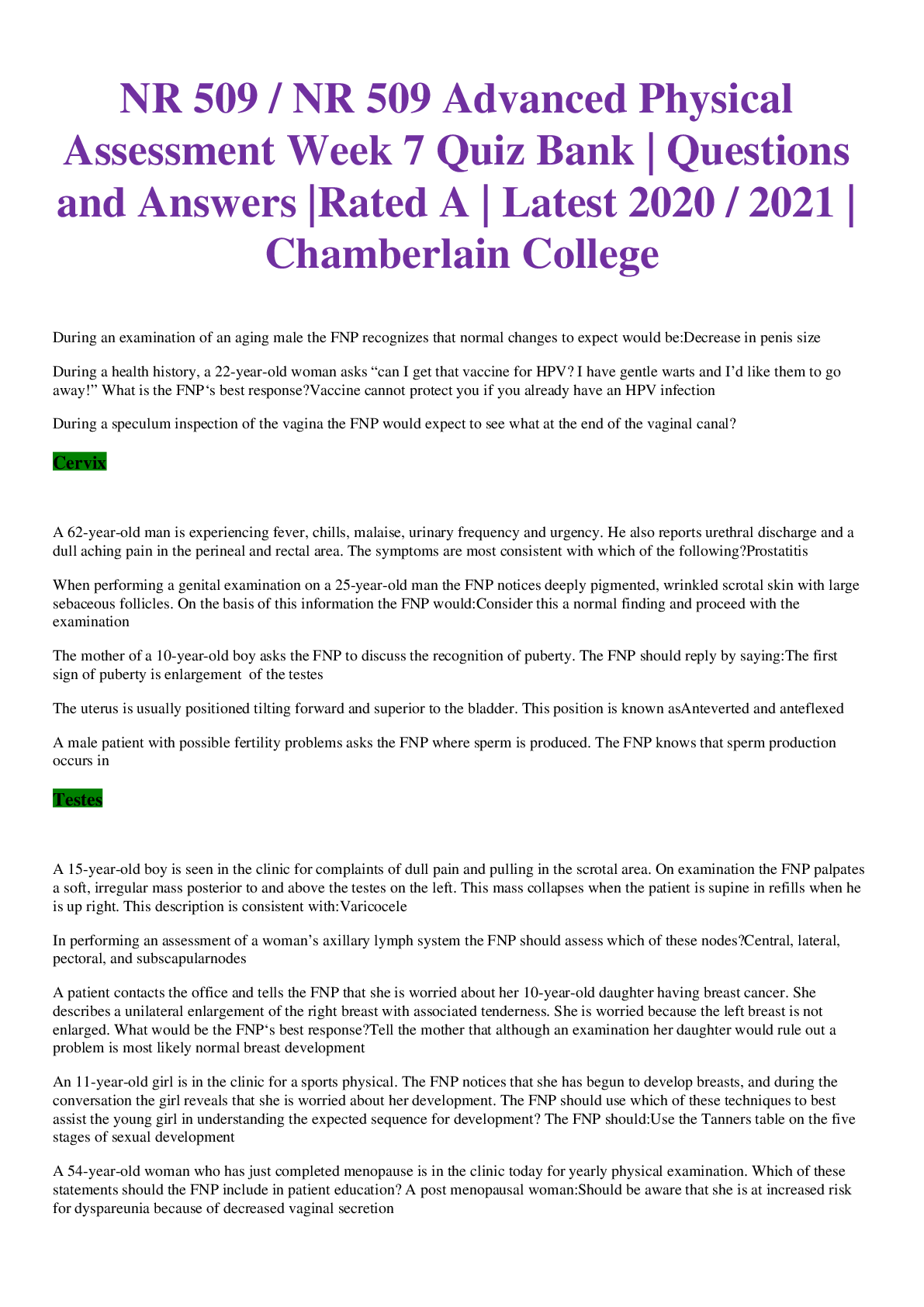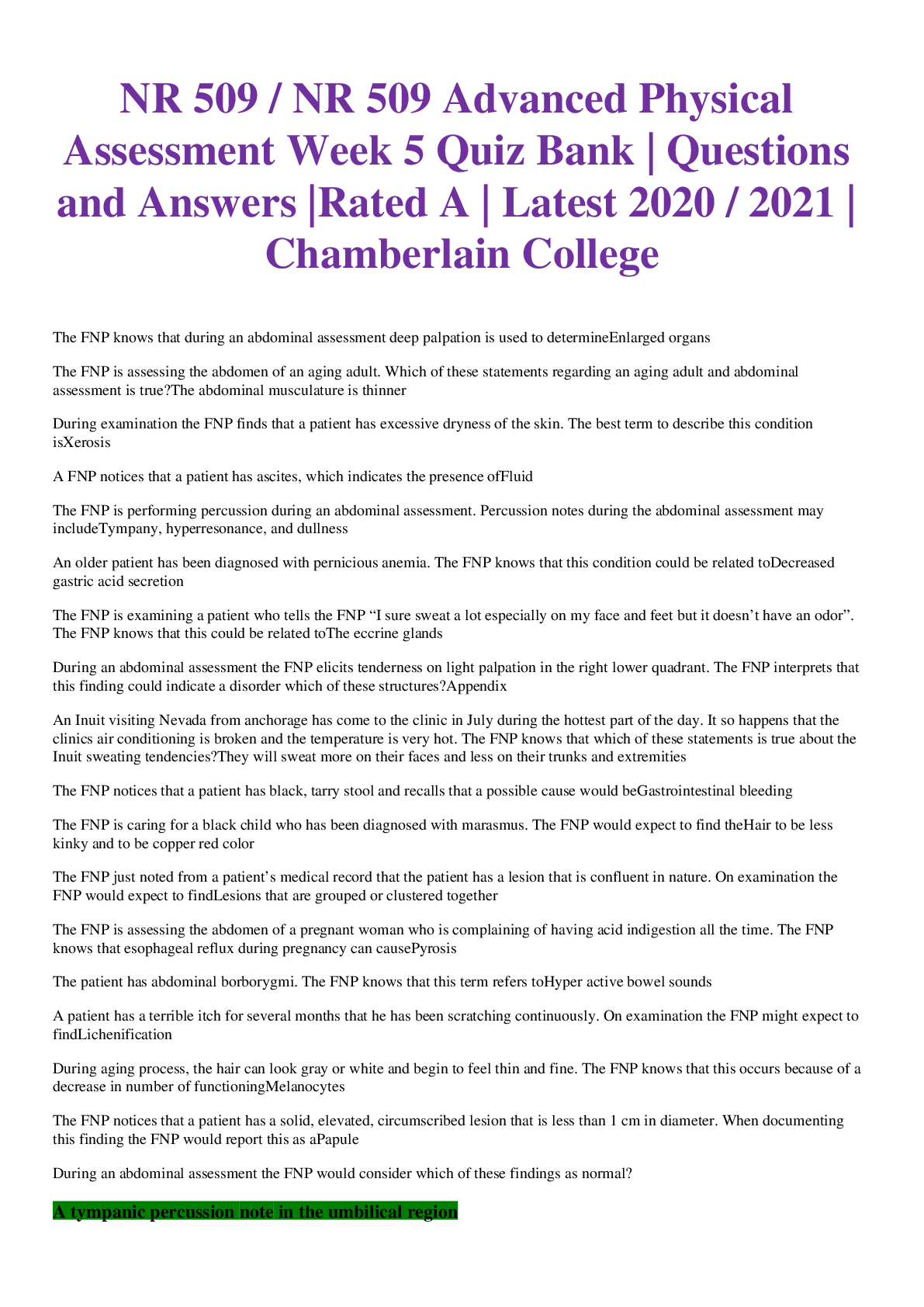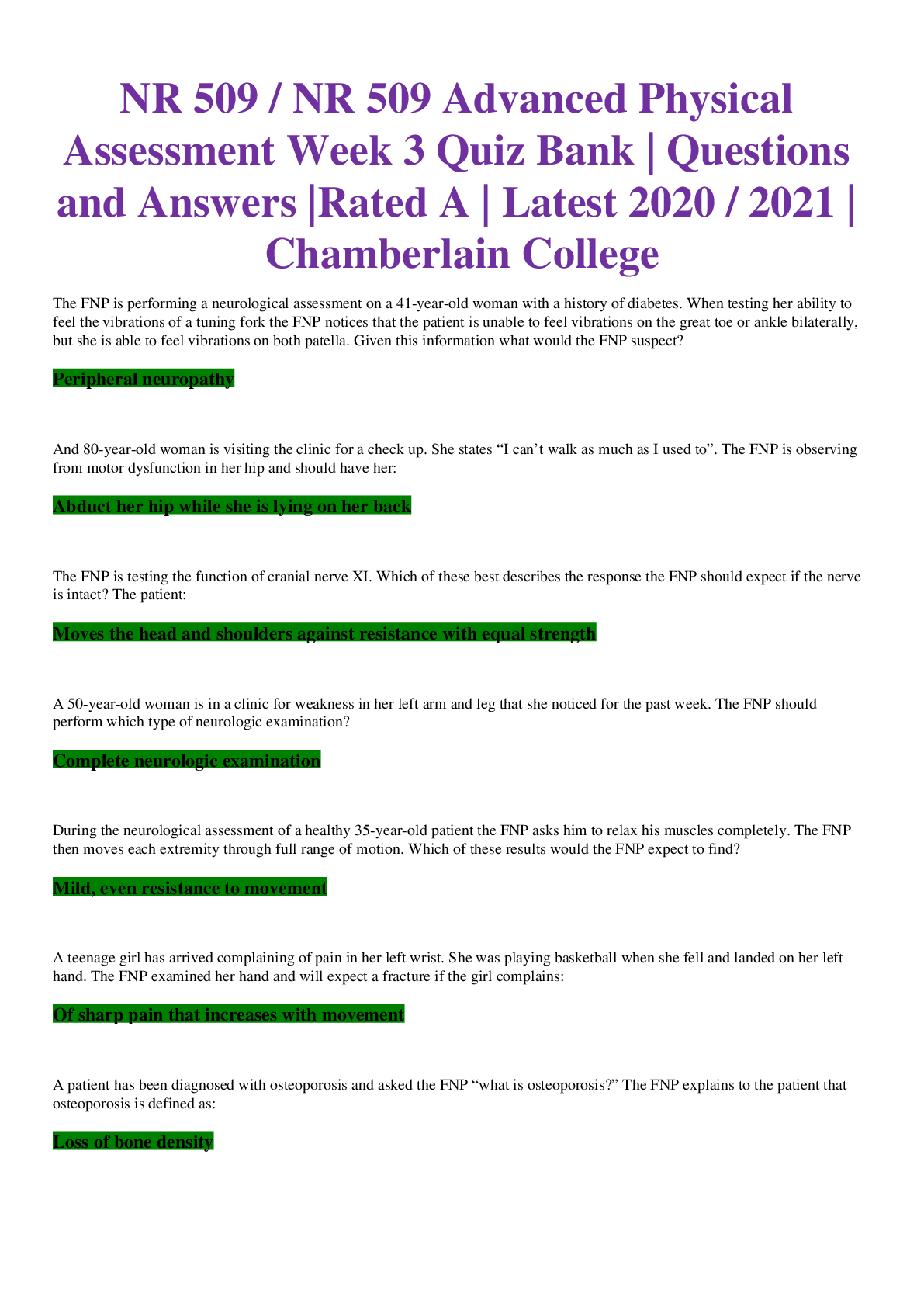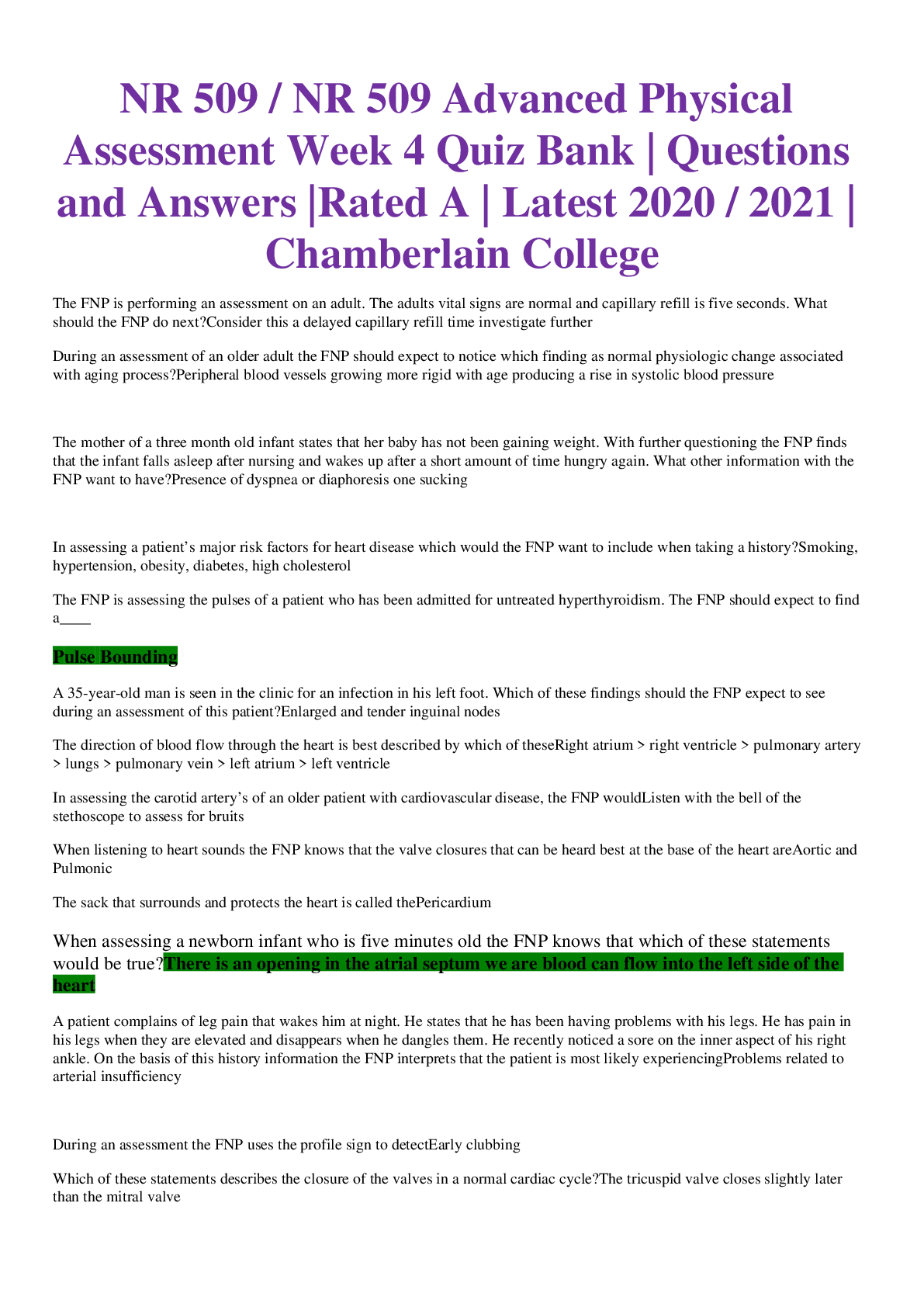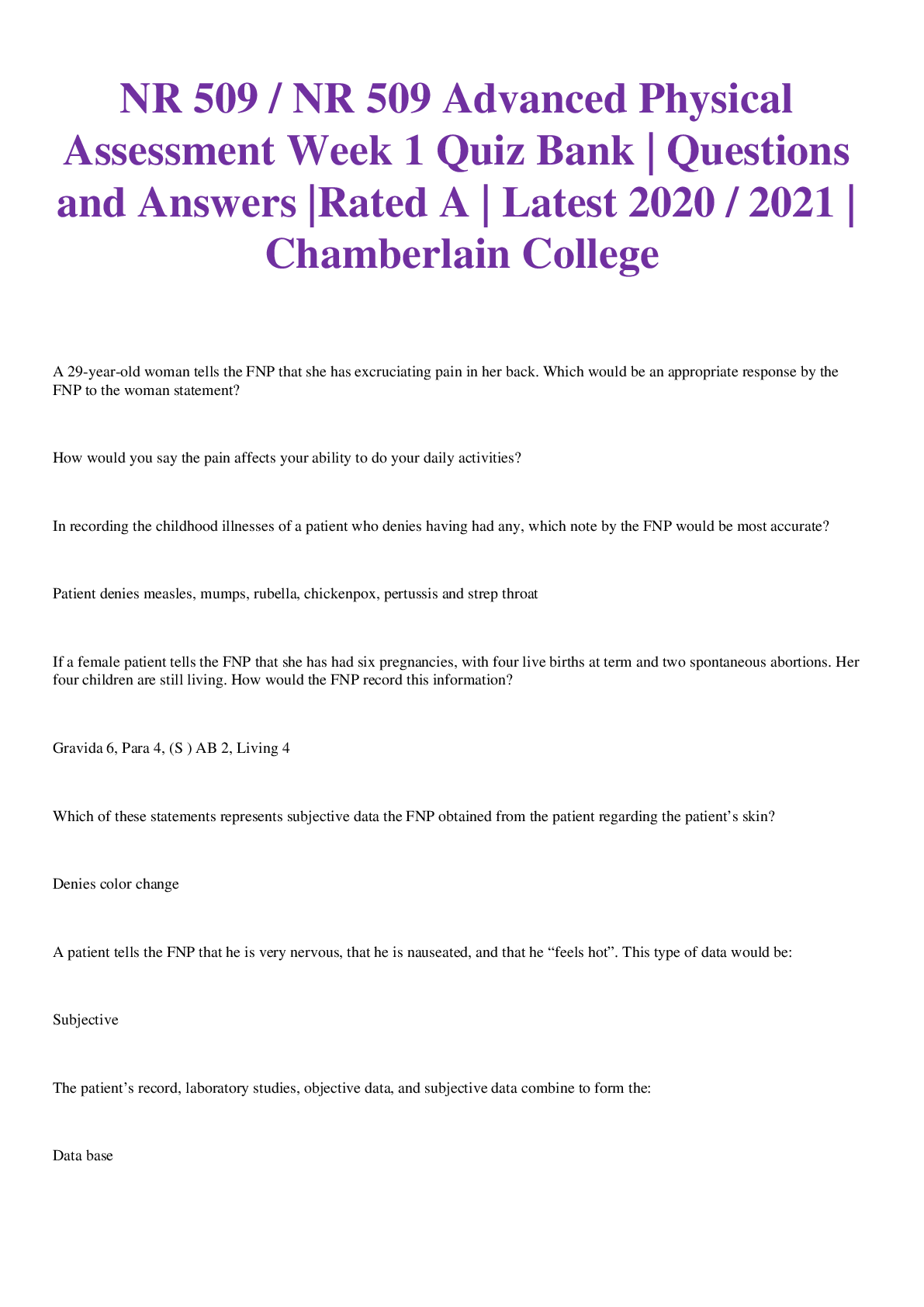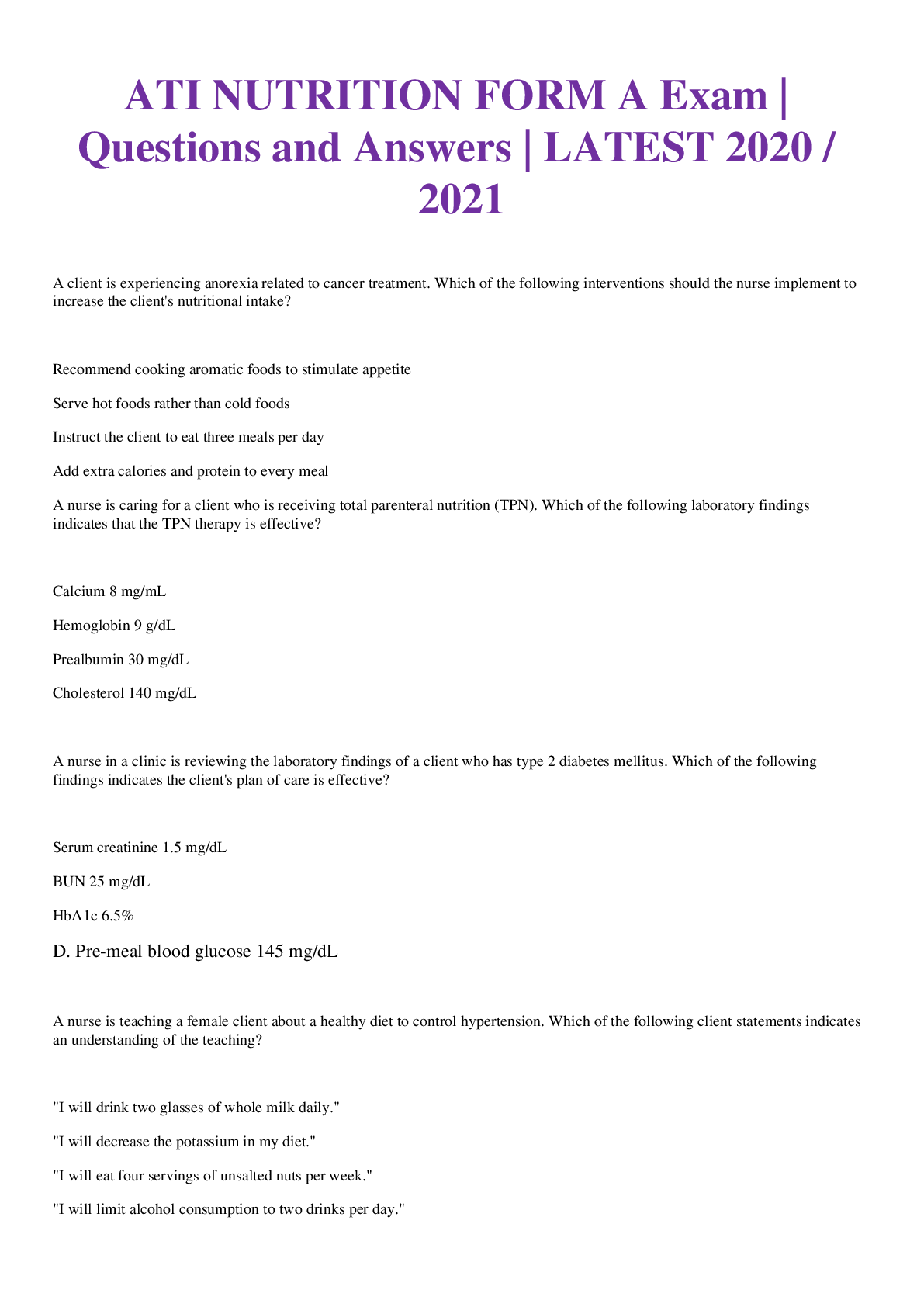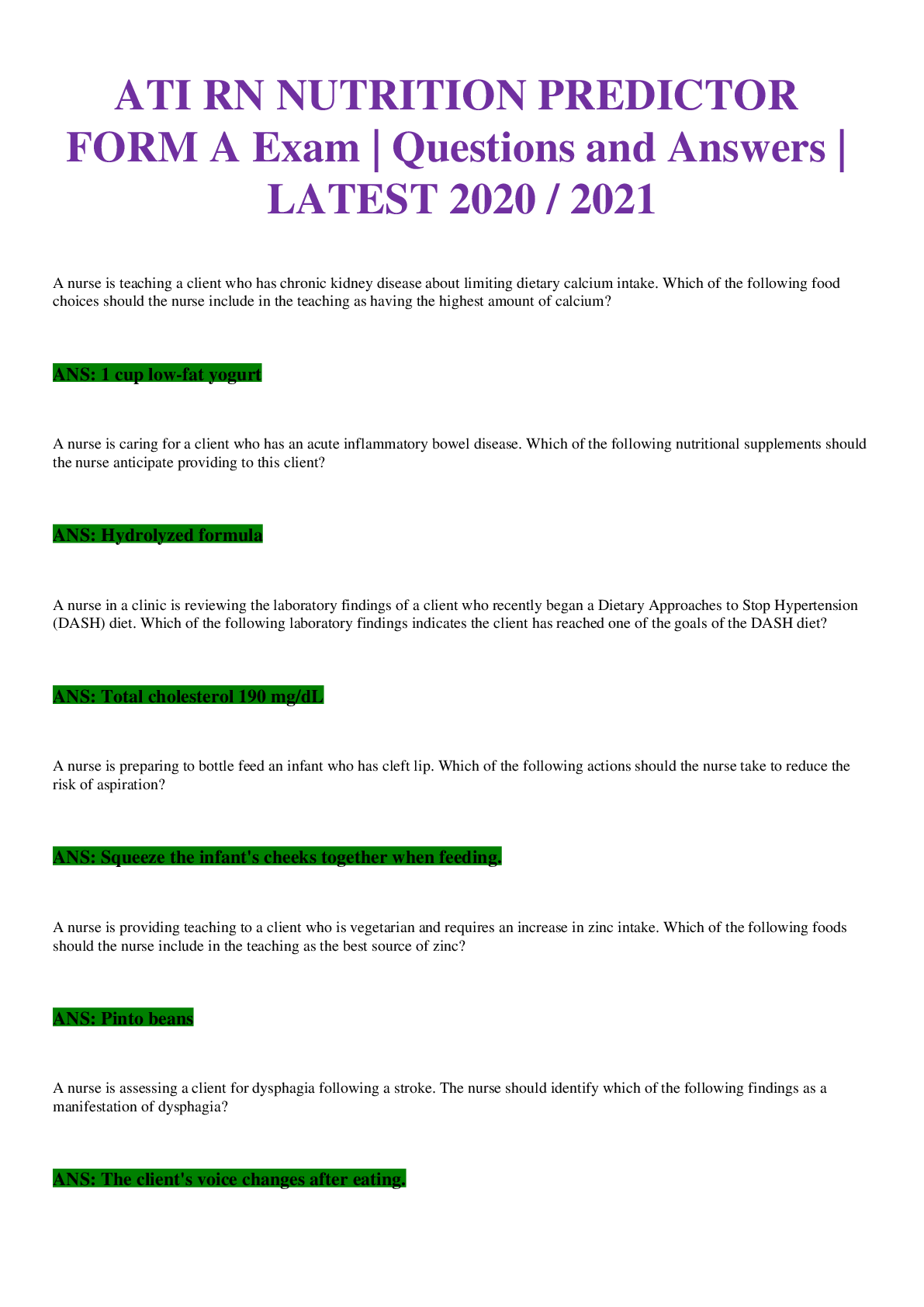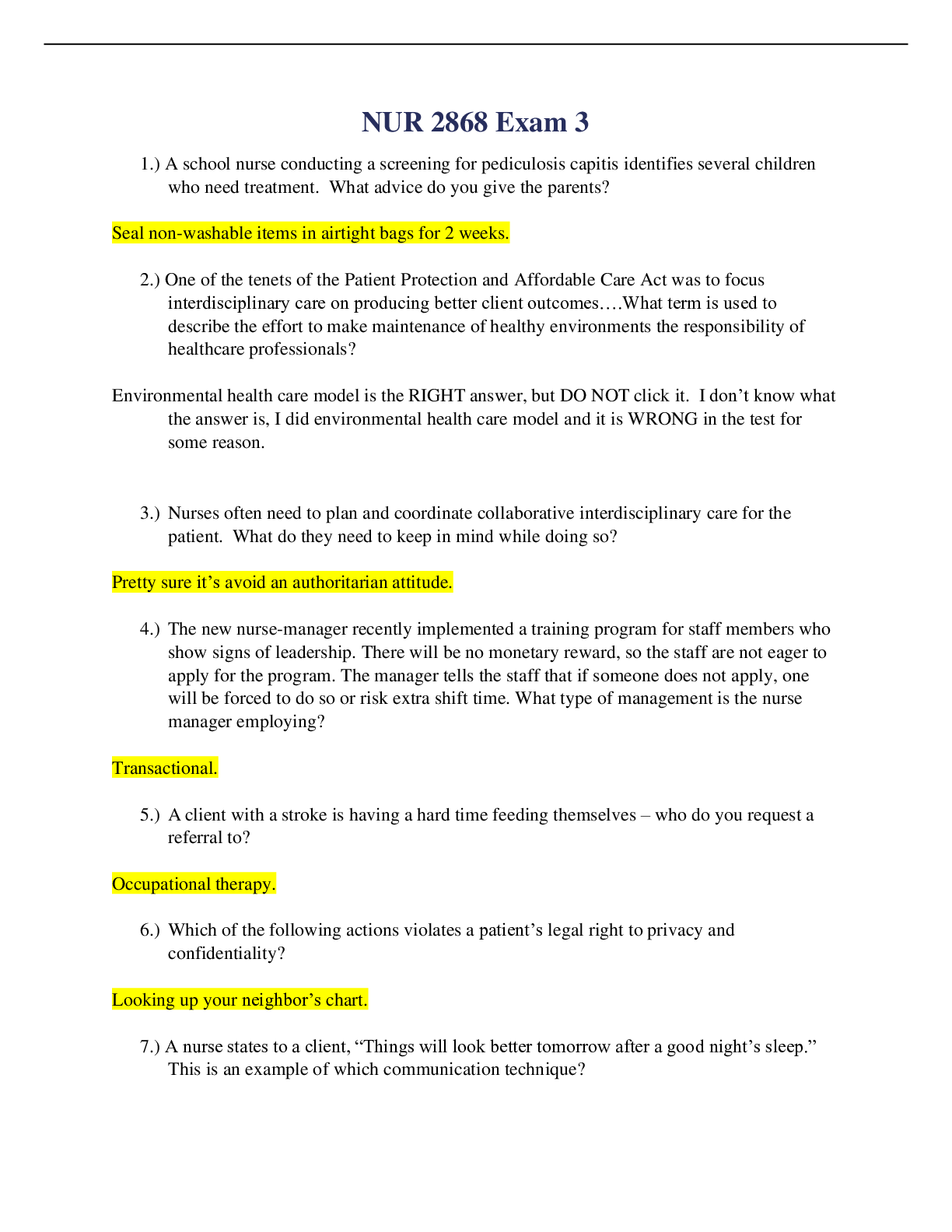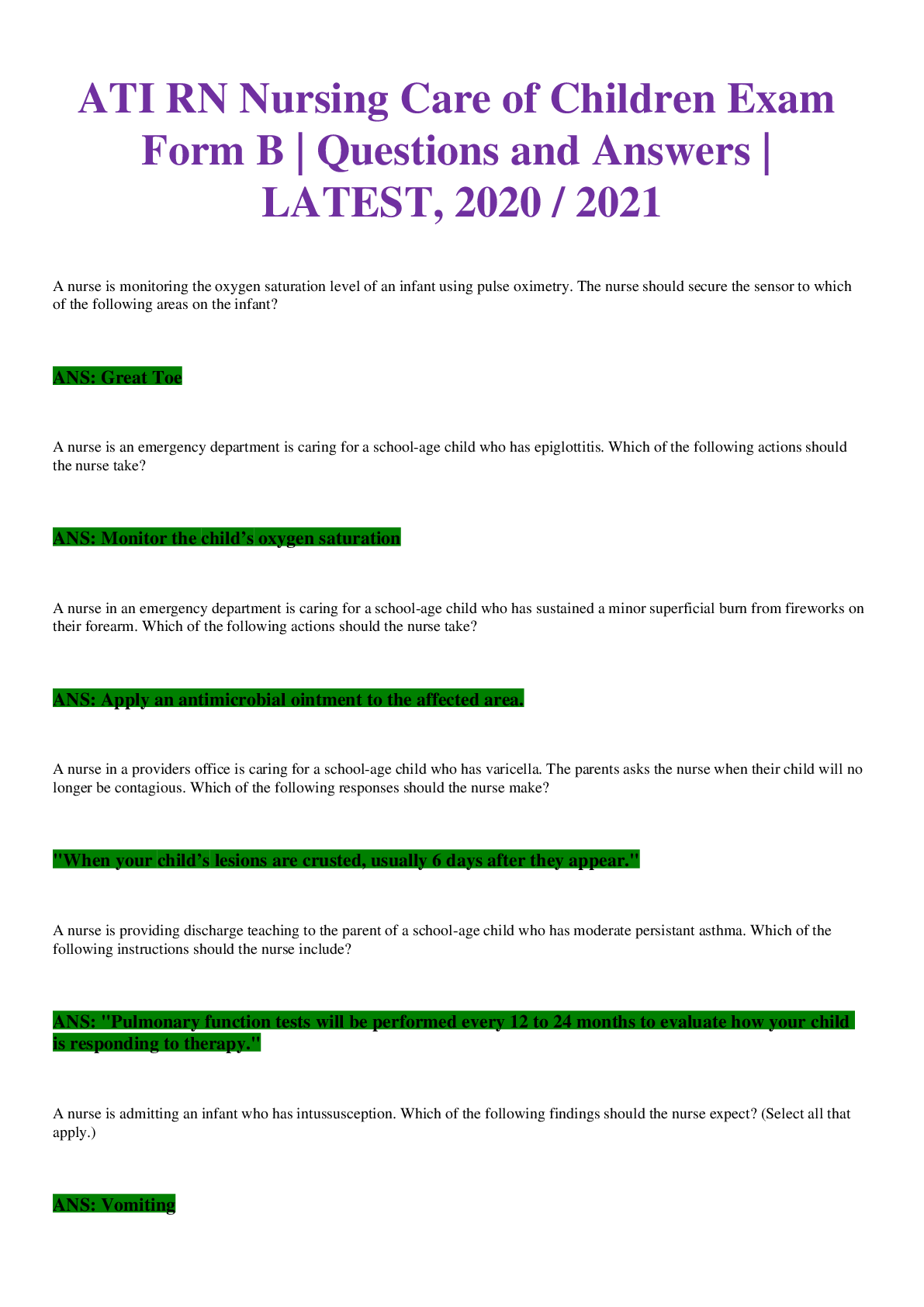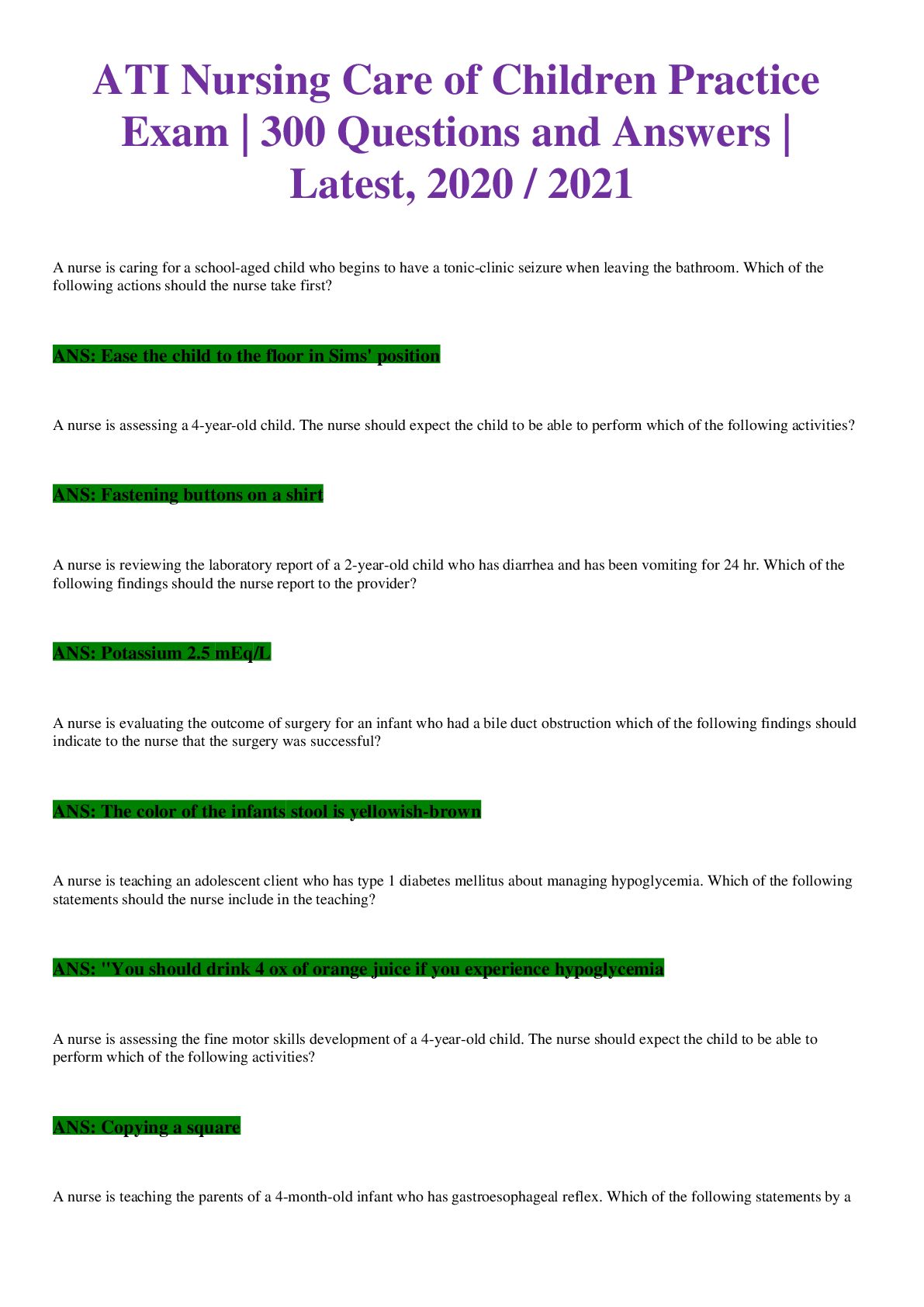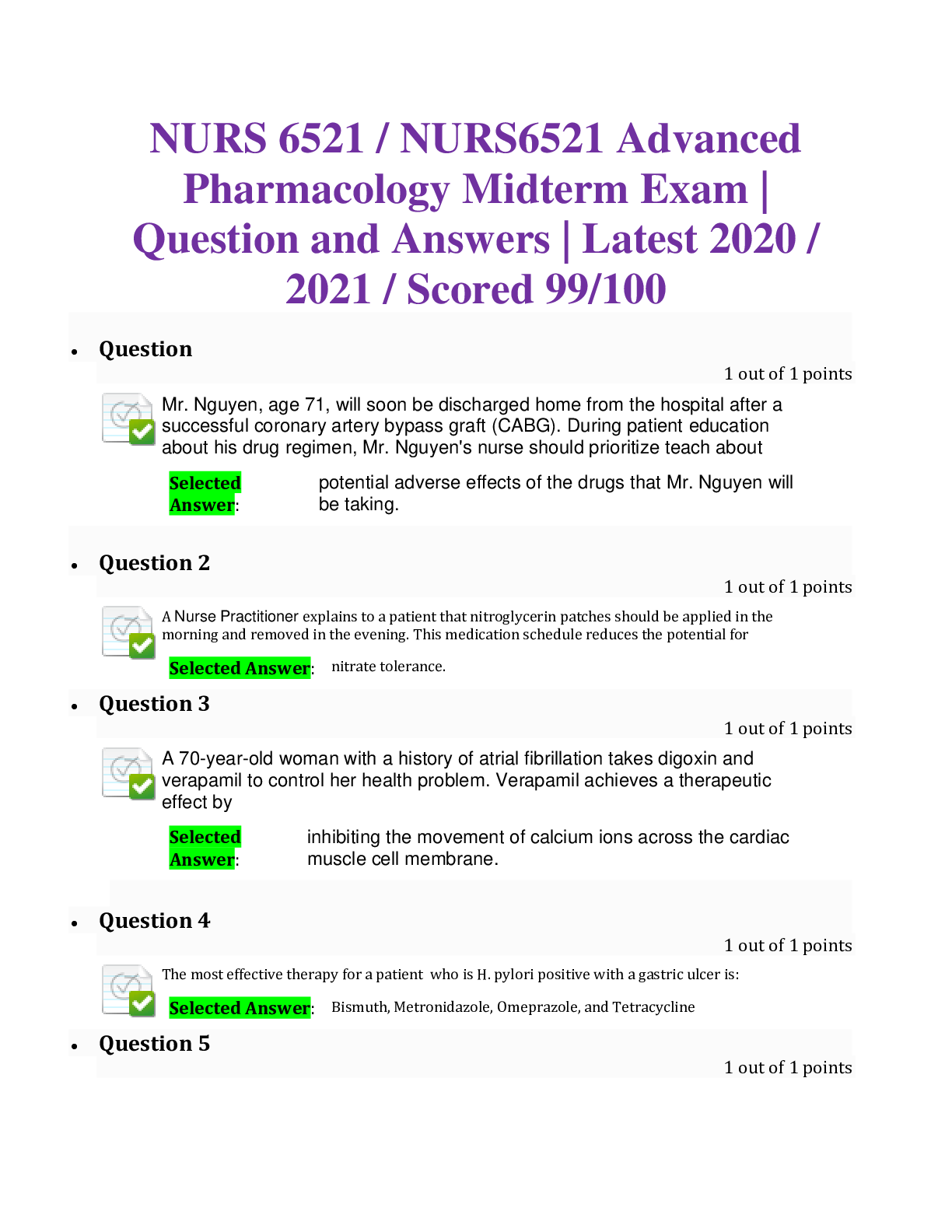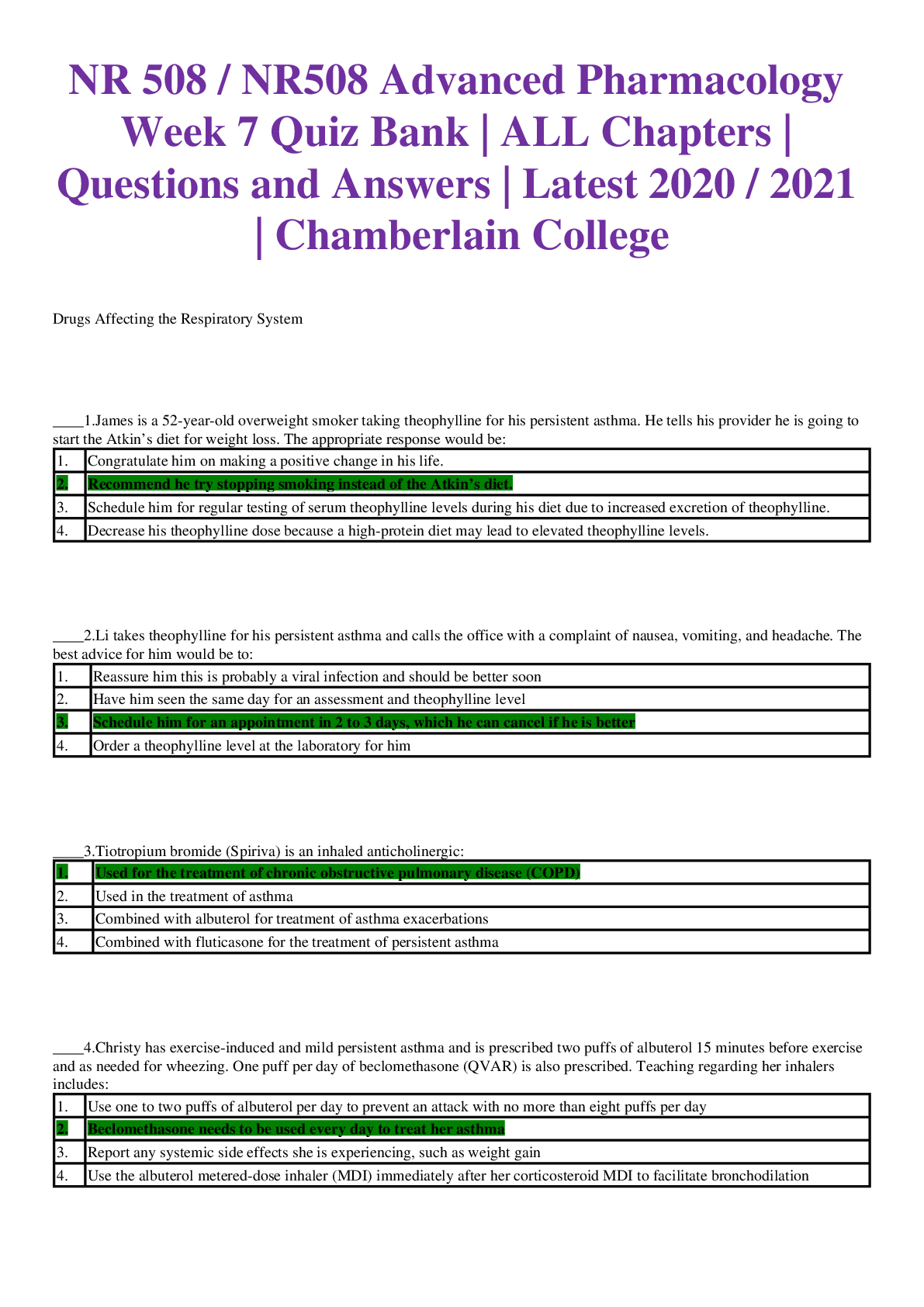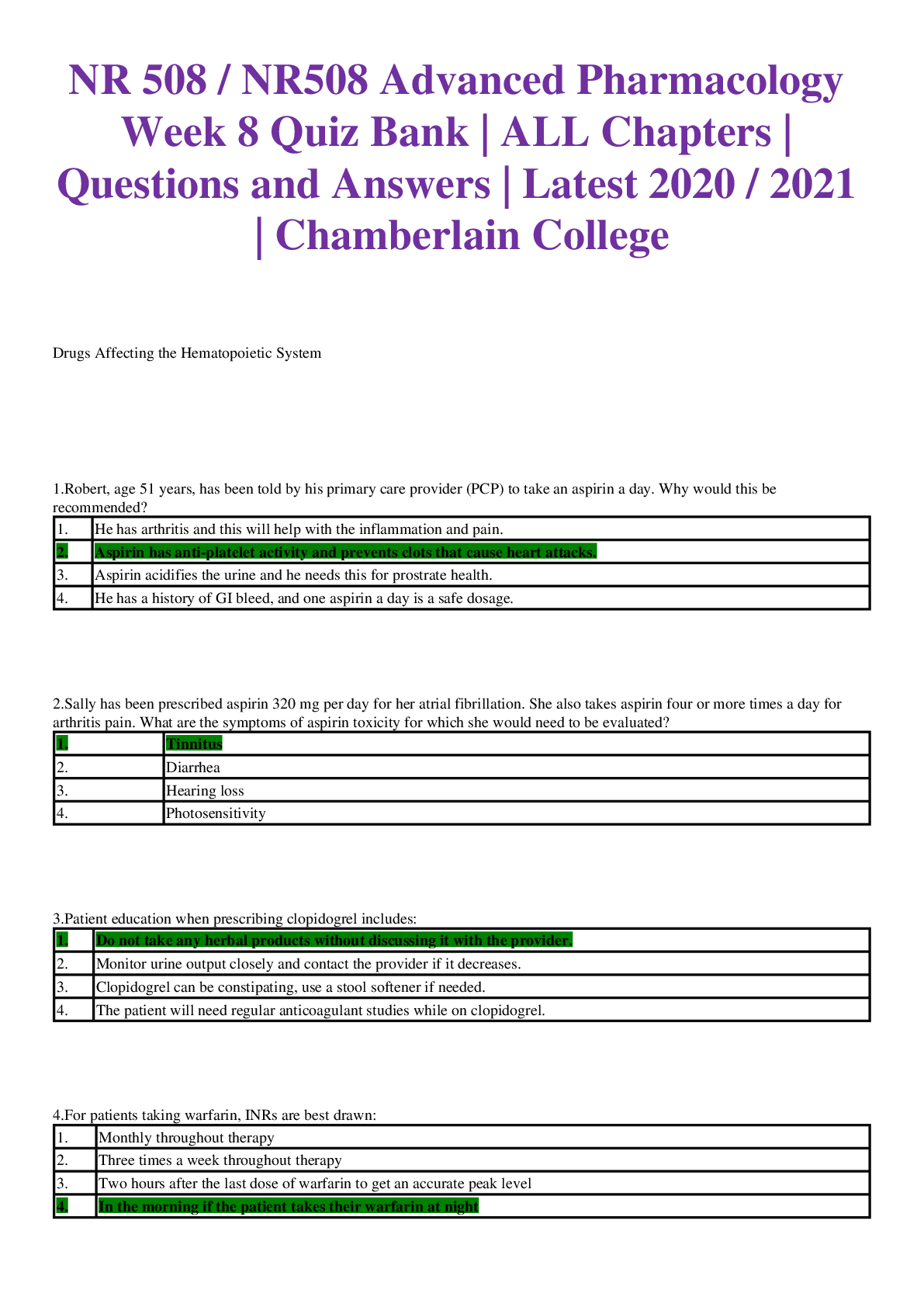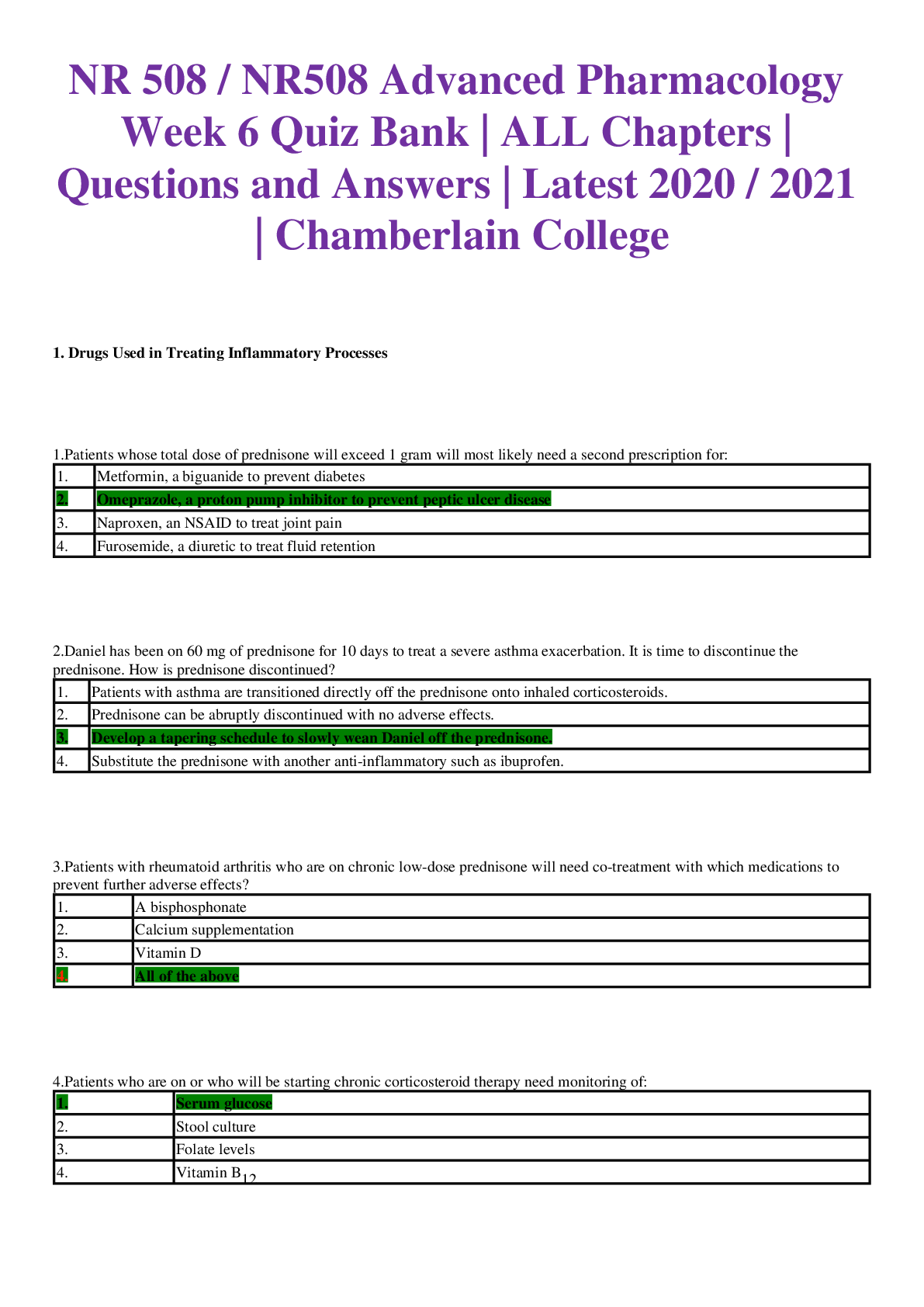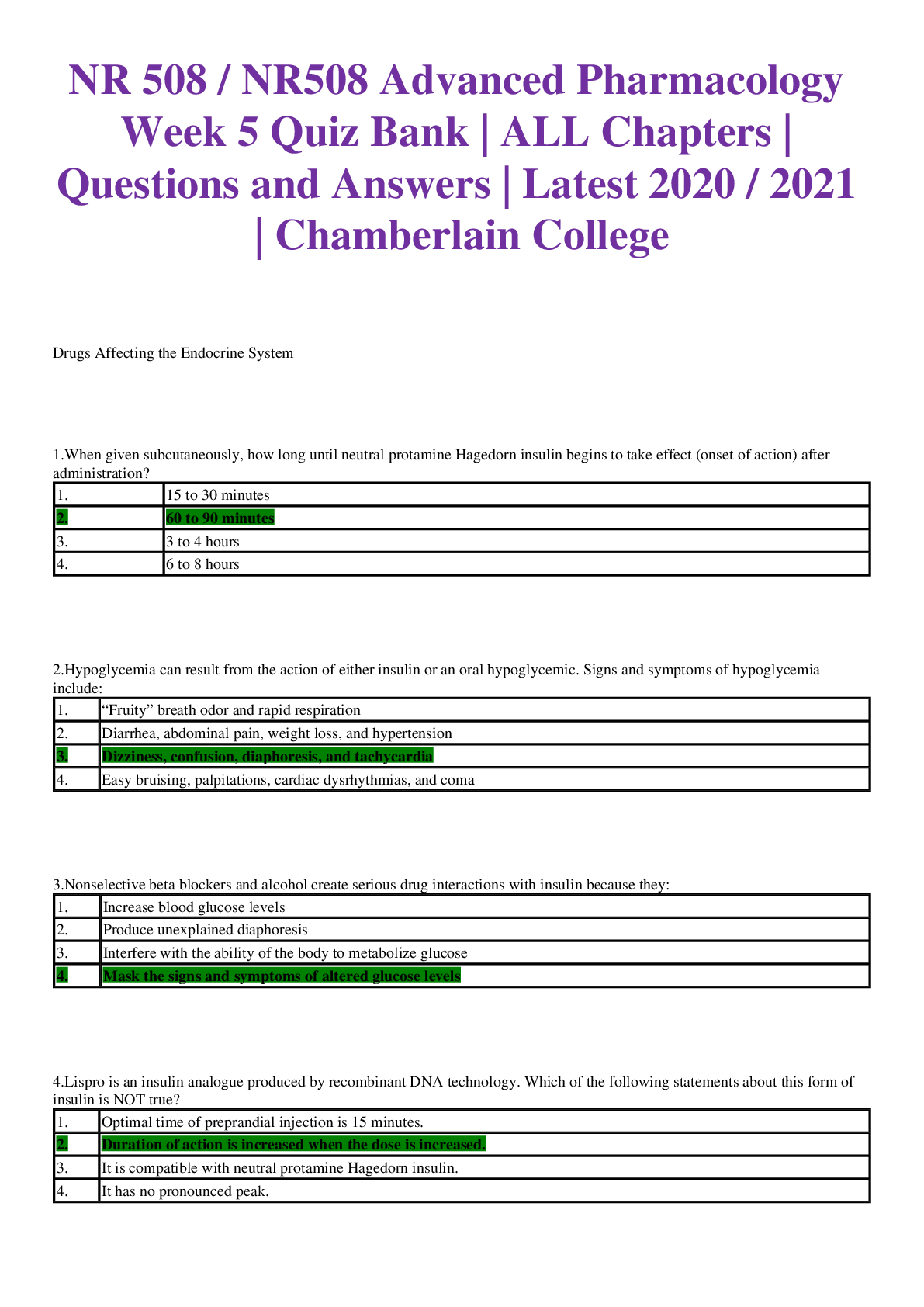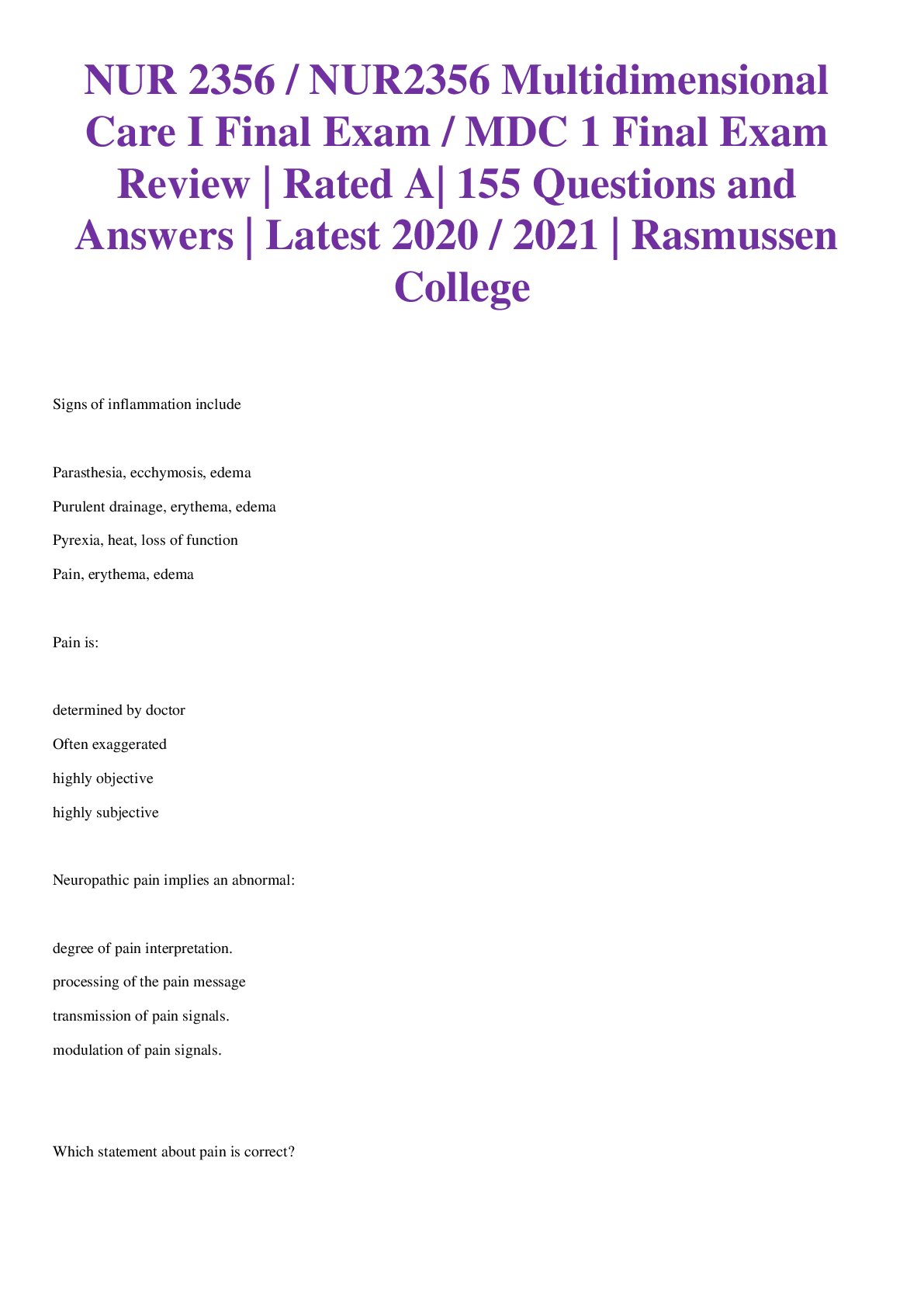Health Care > EXAM > NCLEX Practice Exam 1 Questions and answers | Graded A+ (All)
NCLEX Practice Exam 1 Questions and answers | Graded A+
Document Content and Description Below
NCLEX Practice Exam 1 Questions The nurse is caring for a client scheduled for removal of the pituitary gland. The nurse should be particularly alert for: ❍ A. Nasal congestion ❍ B. Abdominal... tenderness ❍ C. Muscle tetany ❍ D. Oliguria Correct Answer: Answer A is correct. Removal of the pituitary gland is usually done by a transphenoidal approach, through the nose. Nasal congestion further interferes with the airway. Answers B, C, and D are not correct because they are not directly associated with the pituitary gland. A 24-year-old female client is scheduled for surgery in the morning. Which of the following is the primary responsibility of the nurse? ❍ A. Taking the vital signs ❍ B. Obtaining the permit ❍ C. Explaining the procedure ❍ D. Checking the lab work Correct Answer: Answer A is correct. The primary responsibility of the nurse is to take the vital signs before any surgery. The actions in answers B, C, and D are the responsibility of the doctor and, therefore, are incorrect for this question. The nurse is making initial rounds on a client with a C5 fracture and crutchfield tongs. Which equipment should be kept at the bedside? ❍ A. A pair of forceps ❍ B. A torque wrench ❍ C. A pair of wire cutters ❍ D. A screwdriver Correct Answer: Answer B is correct. A torque wrench is kept at the bedside to tighten and loosen the screws of crutchfield tongs. This wrench controls the amount of pressure that is placed on the screws. A pair of forceps, wire cutters, and a screwdriver, in answers A, C, and D, would not be used and, thus, are incorrect. A client is admitted with a Ewing's sarcoma. Which symptoms would be expected due to this tumor's location? ❍ A. Hemiplegia ❍ B. Aphasia ❍ C. Nausea ❍ D. Bone pain Correct Answer: Answer D is correct. Sarcoma is a type of bone cancer; therefore, bone pain would be expected. Answers A, B, and C are not specific to this type of cancer and are incorrect. The nurse is caring for a client with epilepsy who is being treated with carbamazepine (Tegretol). Which laboratory value might indicate a serious side effect of this drug? ❍ A. Uric acid of 5mg/dL ❍ B. Hematocrit of 33% ❍ C. WBC 2,000 per cubic millimeter ❍ D. Platelets 150,000 per cubic millimeter Correct Answer: Answer C is correct. Tegretol can suppress the bone marrow and decrease the white blood cell count; thus, a lab value of WBC 2,000 per cubic millimeter indicates side effects of the drug. Answers A and D are within normal limits, and answer B is a lower limit of normal; therefore answers A, B, and D are incorrect. A 6-month-old client is admitted with possible intussuception. Which question during the nursing history is least helpful in obtaining information regarding this diagnosis? ❍ A. "Tell me about his pain." ❍ B. "What does his vomit look like?" ❍ C. "Describe his usual diet." ❍ D. "Have you noticed changes in his abdominal size?" Correct Answer: Answer C is correct. The least-helpful questions are those describing his usual diet. A, B, and D are useful in determining the extent of disease process and, thus, are incorrect. A client has rectal cancer and is scheduled for an abdominal perineal resection. What should be the priority nursing care during the post-op period? ❍ A. Teaching how to irrigate the illeostomy ❍ B. Stopping electrolyte loss in the incisional area ❍ C. Encouraging a high-fiber diet ❍ D. Facilitating perineal wound drainage Correct Answer: Answer D is correct. The client with a perineal resection will have a perineal incision. Drains will be used to facilitate wound drainage. This will help prevent infection of the surgical site. The client will not have an illeostomy, as in answer A; he will have some electrolyte loss, but treatment is not focused on preventing the loss, so answer B is incorrect. A high-fiber diet, in answer C, is not ordered at this time. The nurse is caring for a client with laryngeal cancer. Which finding ascertained in the health history would not be common for this diagnosis? ❍ A. Foul breath ❍ B. Dysphagia ❍ C. Diarrhea ❍ D. Chronic hiccups Correct Answer: Answer C is correct. Diarrhea is not common in clients with mouth and throat cancer. All the findings in answers A, B, and D are expected findings. Six hours after birth, the infant is found to have an area of swelling over the right parietal area that does not cross the suture line. The nurse should chart this finding as: ❍ A. A cephalohematoma ❍ B. Molding ❍ C. Subdural hematoma ❍ D. Caput succedaneum Correct Answer: Answer A is correct. A swelling over the right parietal area is a cephalohematoma, an area of bleeding outside the cranium. This type of hematoma does not cross the suture line because it is outside the cranium but beneath the periosteum. Answer B, molding, is overlapping of the bones of the cranium and, thus, incorrect. In answer C, a subdural hematoma, or intracranial bleeding, is ominous and can be seen only on a CAT scan or x-ray. A caput succedaneum, in answer D, crosses the suture line and is edema. A client in the cardiac step-down unit requires suctioning for excess mucous secretions. The nurse should be most careful to monitor the client for which dysrhythmia during this procedure? ❍ A. Bradycardia ❍ B. Tachycardia ❍ C. Premature ventricular beats ❍ D. Heart block Correct Answer: Answer A is correct. Suctioning can cause a vagal response and bradycardia. Answer B is unlikely and, therefore, not most important, although it can occur. Answers C and D can occur as well, but they are less likely. The nurse is caring for a client scheduled for a surgical repair of a sacular abdominal aortic aneurysm. Which assessment is most crucial during the preoperative period? ❍ A. Assessment of the client's level of anxiety ❍ B. Evaluation of the client's exercise tolerance ❍ C. Identification of peripheral pulses ❍ D. Assessment of bowel sounds and activity Correct Answer: Answer C is correct. The assessment that is most crucial to the client is the identification of peripheral pulses because the aorta is clamped during surgery. This decreases blood circulation to the kidneys and lower extremities. The nurse must also assess for the return of circulation to the lower extremities. Answer A is of lesser concern, answer B is not advised at this time, and answer D is of lesser concern than answer A. A client with suspected renal disease is to undergo a renal biopsy. The nurse plans to include which statement in the teaching session? ❍ A. "You will be sitting for the examination procedure." ❍ B. "Portions of the procedure will cause pain or discomfort." ❍ C. "You will be given some medication to anesthetize the area." ❍ D. "You will not be able to drink fluids for 24 hours before the study." Correct Answer: Answer B is correct. Portions of the exam are painful, especially when the sample is being withdrawn, so this should be included in the session with the client. Answer A is incorrect because the client will be positioned prone, not in a sitting position, for the exam. Anesthesia is not commonly given before this test, making answer C incorrect. Answer D is incorrect because the client can eat and drink following the test. The nurse is caring for a client with a malignancy. The classification of the primary tumor is Tis. The nurse should plan care for a tumor: ❍ A. That cannot be assessed ❍ B. That is in situ ❍ C. With increasing lymph node involvement ❍ D. With distant metastasis Correct Answer: Answer B is correct. Cancer in situ means that the cancer is still localized to the primary site. Cancer is graded in terms of tumor, grade, node involvement, and mestatasis. Answer A is incorrect because it is an untrue statement. Answer C is incorrect because T indicates tumor, not node involvement. Answer D is incorrect because a tumor that is in situ is not metastasized. The nurse is preparing a client for surgery. Which item is most important to remove before sending the client to surgery? ❍ A. Hearing aid ❍ B. Contact lenses ❍ C. Wedding ring ❍ D. Artificial eye Correct Answer: Answer B is correct. It is most important to remove the contact lenses because leaving them in can lead to corneal drying, particularly with contact lenses that are not extended-wear lenses. Leaving in the hearing aid or artificial eye will not harm the client. Leaving the wedding ring on is also allowed; usually, the ring is covered with tape. Therefore, answers A, C, and D are incorrect. The nurse on the 3-11 shift is assessing the chart of a client with an abdominal aneurysm scheduled for surgery in the morning and finds that the consent form has been signed, but the client is unclear about the surgery and possible complications. Which is the most appropriate action? ❍ A. Call the surgeon and ask him or her to see the client to clarify the information ❍ B. Explain the procedure and complications to the client ❍ C. Check in the physician's progress notes to see if understanding has been documented ❍ D. Check with the client's family to see if they understand the procedure fully Correct Answer: Answer A is correct. It is the responsibility of the physician to explain and clarify the procedure to the client. Answers B, C, and D are incorrect because they are not within the nurse's purview When assessing a client for risk of hyperphosphatemia, which piece of information is most important for the nurse to obtain? ❍ A. A history of radiation treatment in the neck region ❍ B. A history of recent orthopedic surgery ❍ C. A history of minimal physical activity ❍ D. A history of the client's food intake Correct Answer: Answer A is correct. Previous radiation to the neck might have damaged the parathyroid glands, which are located on the thyroid gland, and interfered with calcium and phosphorus regulation. Answer B has no significance to this case; answers C and D are more related to calcium only, not to phosphorus regulation. A client is admitted to the acute care unit. Initial laboratory values reveal serum sodium of 170meq/L. What behavior changes would be most common for this client? ❍ A. Anger ❍ B. Mania ❍ C. Depression ❍ D. Psychosis Correct Answer: Answer B is correct. The client with serum sodium of 170meq/L has hypernatremia and might exhibit manic behavior. Answers A, C, and D are not associated with hypernatremia and are, therefore, incorrect. The nurse is obtaining a history of an 80-year-old client. Which statement made by the client might indicate a possible fluid and electrolyte imbalance? ❍ A. "My skin is always so dry." ❍ B. "I often use a laxative for constipation." ❍ C. "I have always liked to drink a lot of ice tea." ❍ D. "I sometimes have a problem with dribbling urine." Correct Answer: Answer B is correct. Frequent use of laxatives can lead to diarrhea and electrolyte loss. Answers A, C, and D are not of particular significance in this case and, therefore, are incorrect. A client with pancreatitis has been transferred to the intensive care unit. Which order would the nurse anticipate? ❍ A. Blood pressure every 15 minutes ❍ B. Insertion of a Levine tube ❍ C. Cardiac monitoring ❍ D. Dressing changes two times per day Correct Answer: Answer B is correct. The client with pancreatitis frequently has nausea and vomiting. Lavage is often used to decompress the stomach and rest the bowel, so the insertion of a Levine tube should be anticipated. Answers A and C are incorrect because blood pressures are not required every 15 minutes, and cardiac monitoring might be needed, but this is individualized to the client. Answer D is incorrect because there are no dressings to change on this client. The nurse is visiting a home health client with osteoporosis. The client has a new prescription for alendronate (Fosamax). Which instruction should be given to the client? ❍ A. Rest in bed after taking the medication for at least 30 minutes ❍ B. Avoid rapid movements after taking the medication ❍ C. Take the medication with water only ❍ D. Allow at least 1 hour between taking the medicine and taking other medications Correct Answer: Answer C is correct. Fosamax should be taken with water only. The client should also remain upright for at least 30 minutes after taking the medication. Answers A, B, and D are not applicable to taking Fosamax and, thus, are incorrect. The nurse overhears the patient care assistant speaking harshly to the client with dementia. The charge nurse should: ❍ A. Change the nursing assistant's assignment ❍ B. Explore the interaction with the nursing assistant ❍ C. Discuss the matter with the client's family ❍ D. Initiate a group session with the nursing assistant Correct Answer: Answer B is correct. The best action for the nurse to take is to explore the interaction with the nursing assistant. This will allow for clarification of the situation. Changing the assignment in answer A might need to be done, but talking to the nursing assistant is the first step. Answer C is incorrect because discussing the incident with the family is not necessary at this time; it might cause more problems. Answer C is not a first step, even though initiating a group session might be a plan for the future. A home health nurse is planning for her daily visits. Which client should the home health nurse visit first? ❍ A. A client with AIDS being treated with Foscarnet ❍ B. A client with a fractured femur in a long leg cast ❍ C. A client with laryngeal cancer with a laryngetomy ❍ D. A client with diabetic ulcers to the left foot Correct Answer: Answer C is correct. The client with laryngeal cancer has a potential airway alteration and should be seen first. The clients in answers A, B, and D are not in immediate danger and can be seen later in the day. The graduate licensed practical nurse is assigned to care for the client on ventilator support, pending organ donation. Which goal should receive priority? ❍ A. Maintain the client's systolic blood pressure at 70mmHg or greater ❍ B. Maintain the client's urinary output greater than 300cc per hour ❍ C. Maintain the client's body temperature of greater than 33°F rectal ❍ D. Maintain the client's hematocrit less than 30% Correct Answer: Answer A is correct. When the cadaver client is being prepared to donate an organ, the systolic blood pressure should be maintained at 70mmHg or greater to ensure a blood supply to the donor organ. Answers B, C, and D are incorrect because they are unnecessary actions for organ donation. Which of the following roommates would be best for the client newly admitted with gastric resection? [Show More]
Last updated: 1 year ago
Preview 1 out of 20 pages

Reviews( 0 )
Document information
Connected school, study & course
About the document
Uploaded On
Jul 25, 2022
Number of pages
20
Written in
Additional information
This document has been written for:
Uploaded
Jul 25, 2022
Downloads
0
Views
27


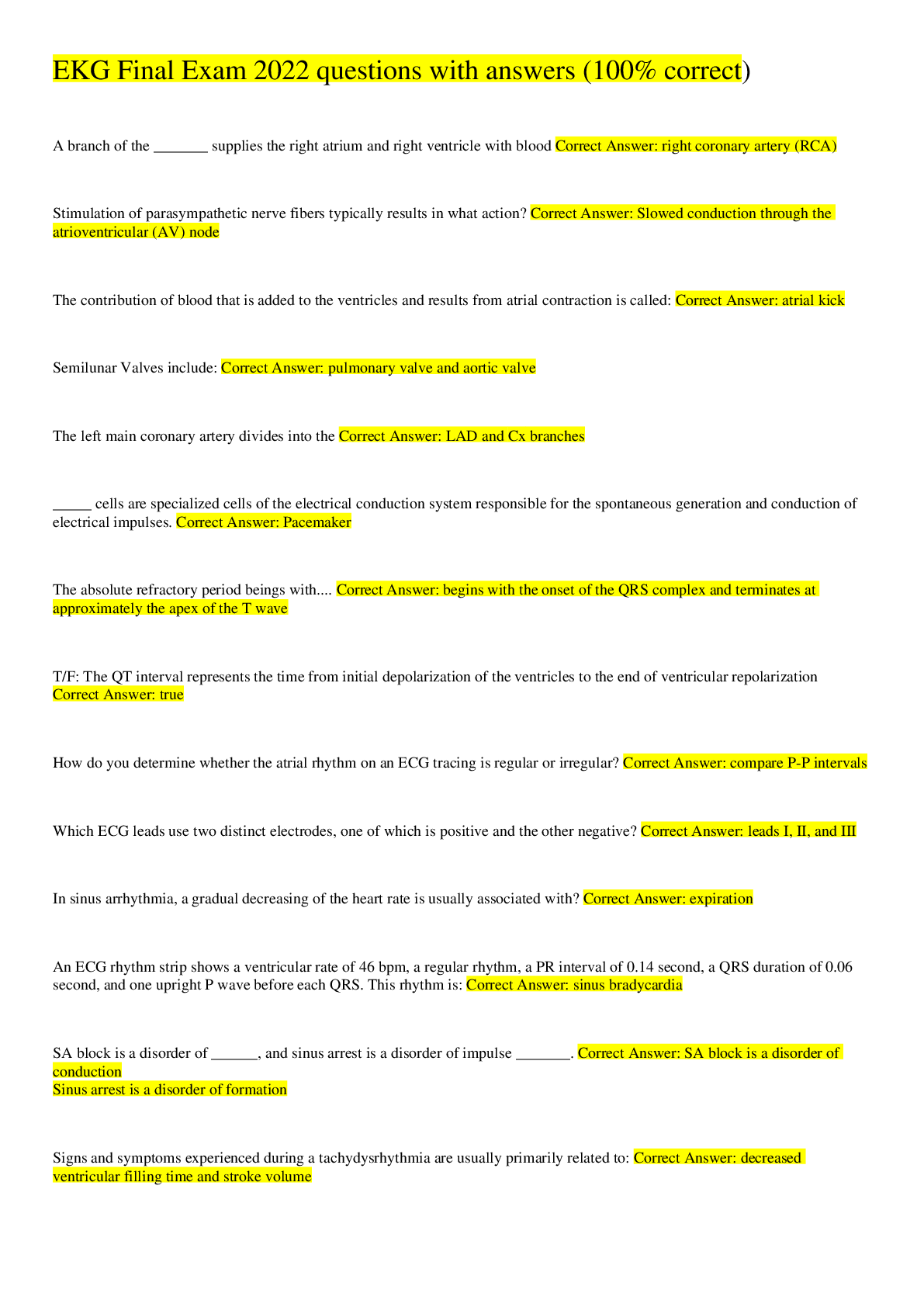
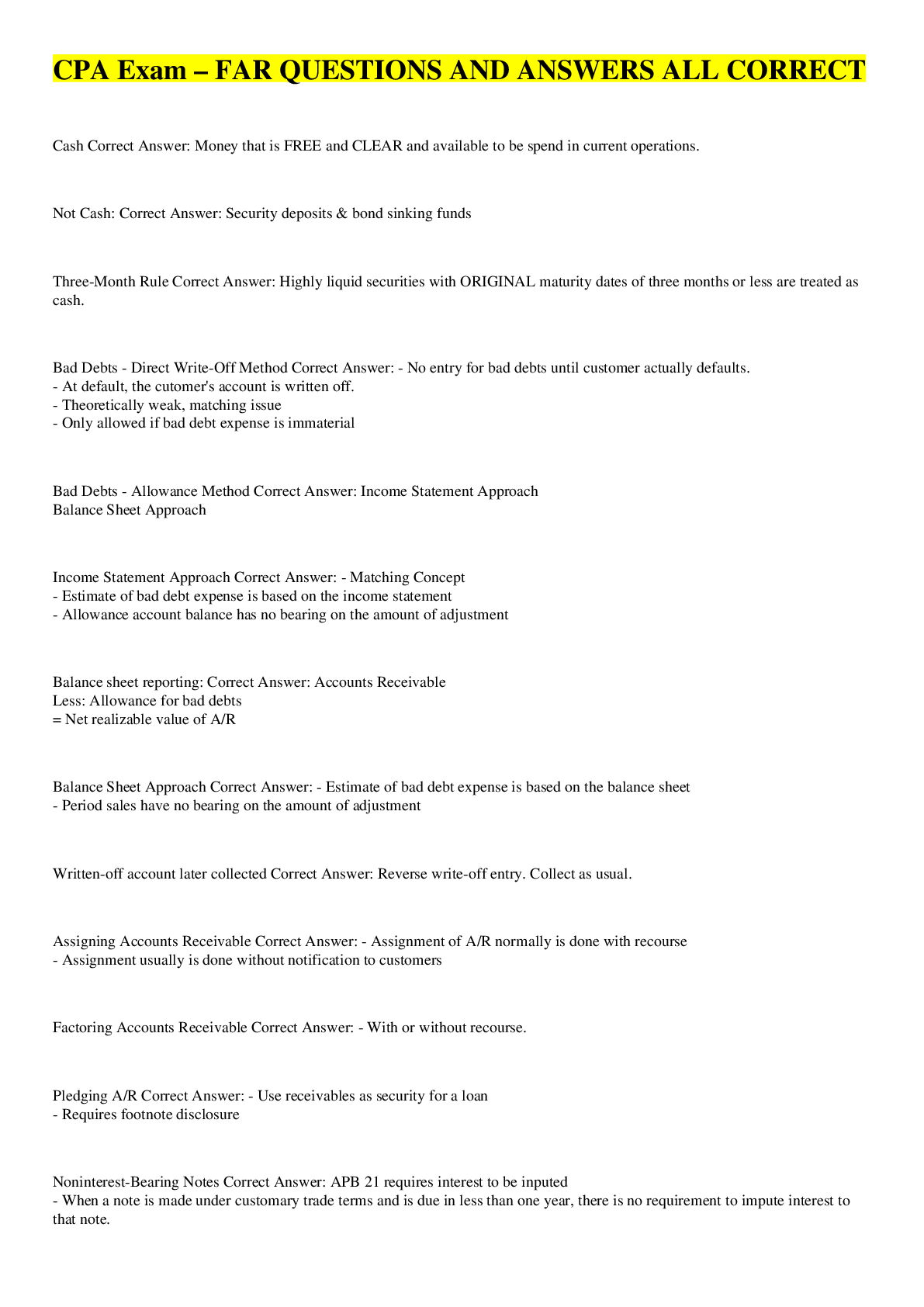
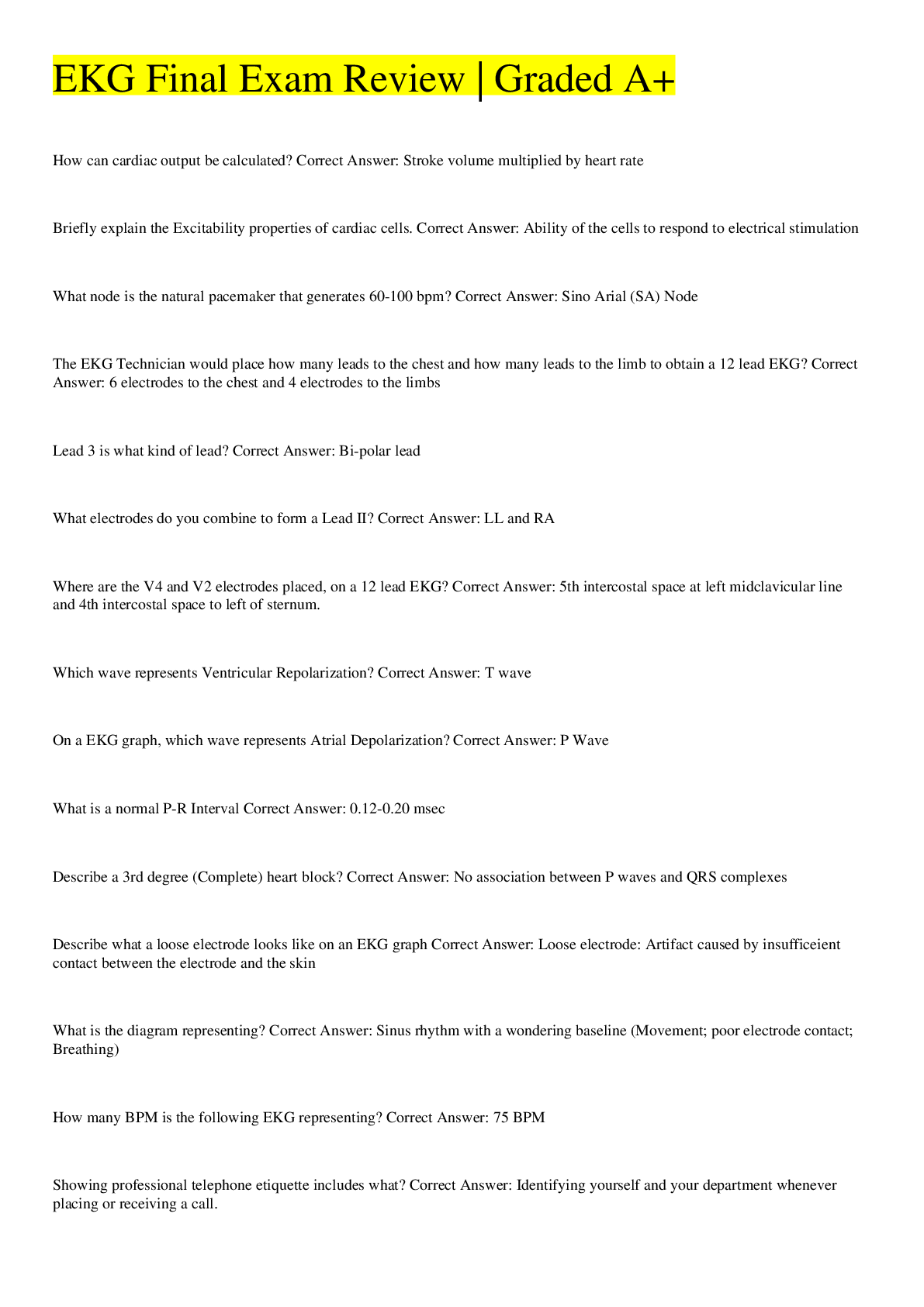
.png)

